Occupying half of South America’s landmass, Brazil is the most biodiverse country in the world. It contains the world’s largest rainforest, the Amazon and the world’s largest tropical wetland, the Pantanal. Together with the last remnants of the Atlantic rainforest, these ecosystems are home to some extraordinary Brazilian animals.
In fact, the wildlife of Brazil is so rich and diverse that scientists are still discovering new species. Many Brazilian wildlife species are endemic to the country, meaning they do not occur anywhere else on earth. Curious which Brazilian animals are endemic to Brazil? Then check the FAQ below.
So, what animals live in Brazil?
In Brazil, animals are as abundant as they are diverse. There are jaguars, tapirs, otters, monkeys, caimans, macaws, hummingbirds, anacondas, piranha and so much more. Read on to find out what animals you can spot on your travels in Brazil
What animal is Brazil known for?
Brazil is probably best known for its incredible diversity of monkeys, but the national animal of Brazil is the magnificent jaguar. Brazil is the best place in the world to see these charismatic cats.
What are some of the unique Brazilian animals?
Brazil has one of the greatest variety of endemic species in the world. Endemic, means that the species does not occur anywhere else in the world. Among mammals, Brazil’s endemic species include maned sloth, Brazilian three-banded armadillo, hoary fox, bristle-spined porcupine, a number of bat and rodent species and of course many primates.
To get a sense of just how unique Brazilian wildlife is, here are some of the primates that occur only in Brazil: red-handed howling monkey, northern brown howling monkey, white-whiskered spider monkey, southern muriqui, northern muriqui, white-eared marmoset, buffy-headed marmoset, black-faced lion tamarin, golden-headed lion tamarin, black lion tamarin, golden lion tamarin, pied tamarin, Ka’apor capuchin, crested capuchin, yellow-breasted capuchin, Vanzolini’s squirrel monkey, white bald-headed uakari, Novaes’ bald-headed uakari, northern Bahian blond titi, Coimbra-Filho’s titi, Atlantic titi, bearded saki and Uta Hick’s bearded saki.
What is the most common animal in Brazil?
Capybara is probably the most common animal in Brazil. The first capybara I saw in Brazil was grazing peacefully on the side of the road that runs from Sao Paulo airport to the city.
Are there tigers in Brazil?
No, tigers are restricted to Asia. Brazil’s only big cat is the jaguar.
What big cats live in Brazil?
Brazil’s largest terrestrial predator and the country’s only big cat is the jaguar. There are also pumas living in Brazil, but technically, they belong to the small cat family.
What is Brazil’s Big Five?
That’s right, Brazil has its own ‘Big Five’. They are the giants of the Brazilian jungle: jaguar, Brazilian tapir, giant anteater, maned wolf and giant river otter.
Here is a guide to 35 amazing Brazilian animals, including Brazil’s Big Five that you can encounter on your travels in Brazil, together with suggestions on the best places for spotting wildlife in Brazil.
READ MORE: Where to see wildlife in Brazil without breaking the budget?
Jaguar – the National Animal of Brazil
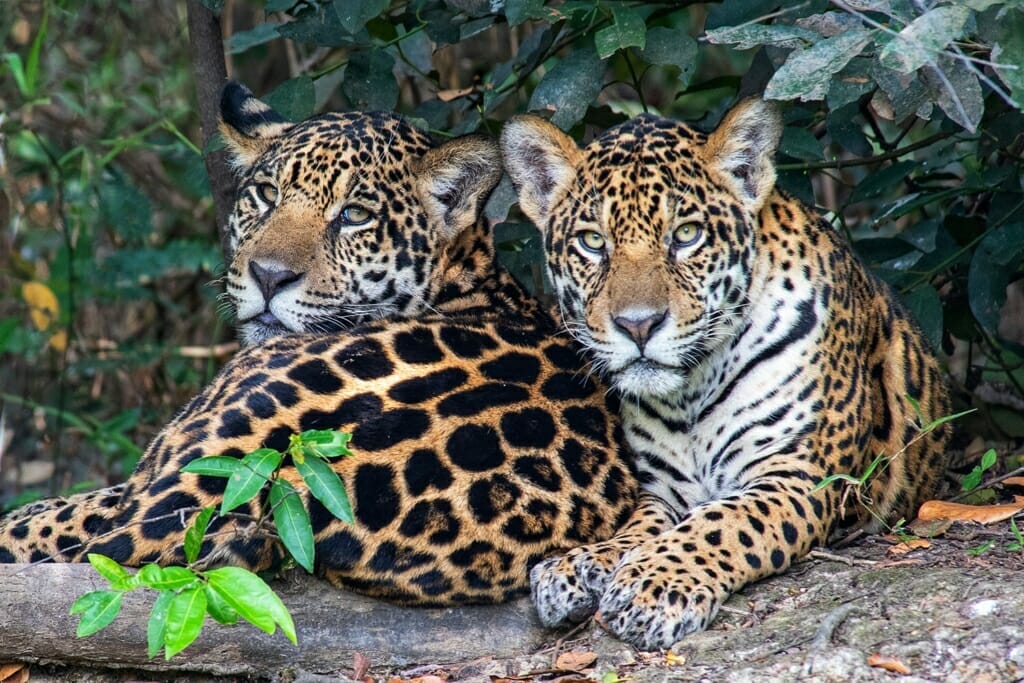
Solitary and elusive, jaguars are the largest wild cats in the Americas and the third-largest big cats in the world (after tigers and lions). They have the most powerful bite among the big cats and can crush the skull of a fully-grown caiman.
The jaguars once ranged from the southern United States to northern Argentina. Today, they occupy only about 50 percent of their historic range and are listed as “Near Threatened” on the International Union for Conservation of Nature (IUCN) Red List of Threatened Species.
And this range keeps shrinking due to habitat destruction and degradation in the human-dominated world.
Currently, there are two strongholds for jaguars in Brazil. In the north of the country, the Amazon rainforest is home to the largest population of jaguars in the world. Further south, pretty much dab smack in the middle of the country, the Pantanal is home to the second-largest population.
So what is the best place in the world to see the national animal of Brazil in the wild? The Brazilian Pantanal. Unlike the Amazon, the Pantanal is an open landscape that presents the perfect stage for spotting some of the most iconic Brazilian wildlife. The network of streams and ox-bow lakes, upstream from the small fishing community of Porto Jofre (250 km from Cuiaba) is the best place for watching jaguars in the wild. Here is your best chance to see a ‘shadow’ of jaguars, which is a collective noun used for a group of jaguars
READ MORE: 50 Outstanding Safari Holidays Destinations Outside of Africa
Ocelot
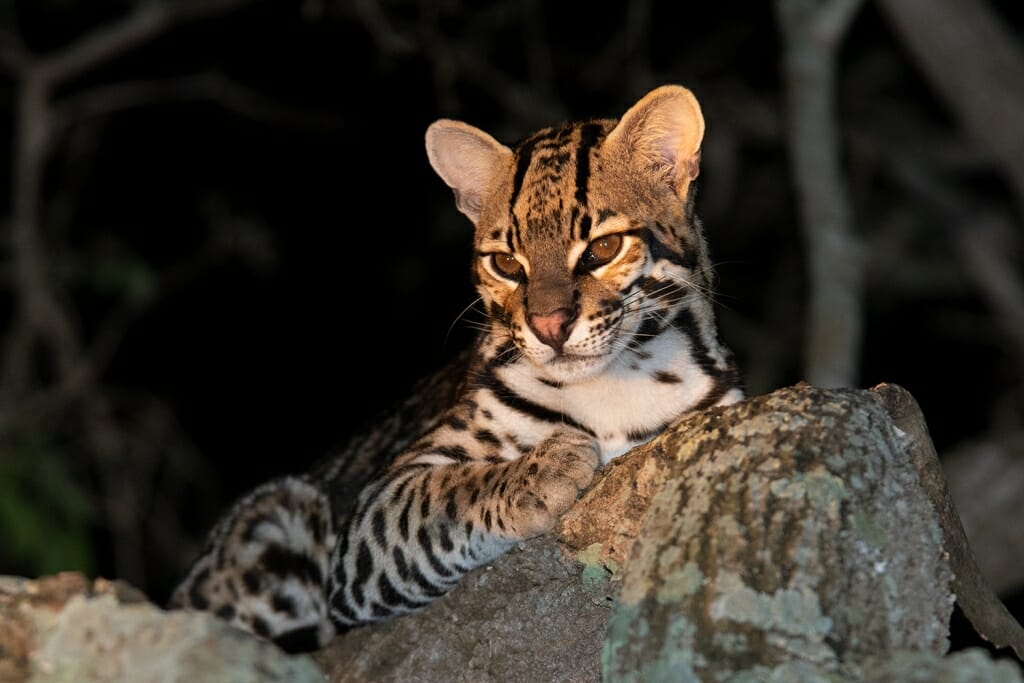
At about twice the size of a domestic cat, Ocelot is the largest small cat in the Americas. It has a similar distribution range to the jaguar, from Texas and Arizona all the way to northern Argentina.
In the past, ocelots were heavily hunted for their beautiful coat, but today they are protected across most of their range. And while they are still threaded by the loss of habitat, ocelots are listed as “Least Concern” on the IUCN Red List of Threatened Species.
Curiously, ocelots, together with the other seven small spotted cats of South America, have 36 chromosomes rather than 38, like all other wild cats!
Spotting an ocelot in the wild is a challenging task unless you know where to look. The highest density of ocelots in the world is found on Barro Colorado Island in Panama. The island was formed during the creation of the Panama Channel. As the countryside flooded, the animals moved to higher ground and many become trapped on what is now Barro Colorado Island.
However, the best place to see an ocelot in the wild is Fazenda San Francisco in Brazil’s southern Pantanal. The rice paddies of the fazenda attract a high number of rodents and the ocelots follow their prey.
On top of the rodents, the irrigation channels that bring water from the nearby river to the fields, are teeming with fish and other aquatic vertebrates. The ocelots have no shortage of food here and their relaxed attitude to safari vehicles allows for some close encounters (like the image above).
Of course, the southern Pantanal is not all about the ocelots. It is one of the best places to see a variety of Brazilian wildlife including jaguars, anteaters and an incredible abundance and diversity of birds.
Puma
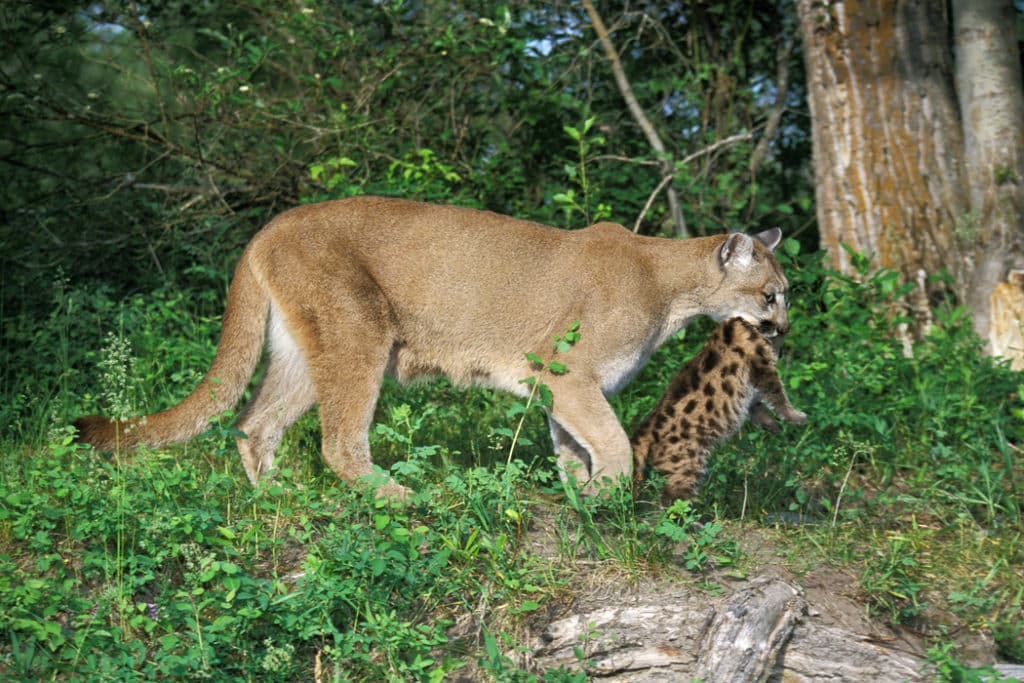
The second-largest cat in Brazil, after the jaguar, puma (a.k.a. cougar) is quite rare in the country. While puma has one of the widest distribution ranges among felids, it tends to occur at low density in most places. The Pantanal is, of course, the best place to try your luck at spotting a puma, particularly, Fazenda Barranco Alto in the southern Pantanal.
However, some of the most extraordinary images of a puma ever taken were snapped by a camera trap in Serra dos Órgãos National Park in 2013. In these images, a magnificent young male with a flawless white coat strides confidently past the camera. This was the first-ever confirmed case of a wild cougar with leucism – a genetic condition characterized by partial loss of pigmentation.
Maned Wolf
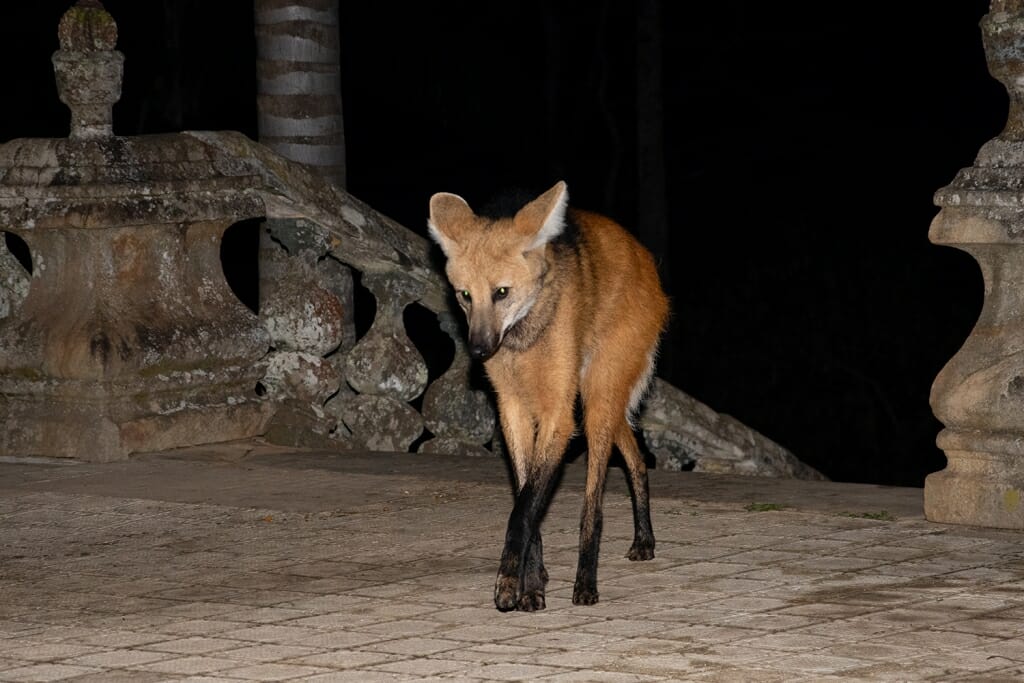
South America’s Maned wolf, is a wolf, like no other. Looking like a fox on stilts, it is neither a fox nor a wolf. It is the only canid (a member of the wild dog family) of its kind. This may mean that it is the only survivor of the Pleistocene extinction that wiped out the majority of the megafauna, including the Woolly mammoth.
Having survived for a million years, it is now listed as “Near Threatened” on the IUCN Red List of Threatened Species and considered “Vulnerable” in Brazil.
The maned wolves are impressive-looking animals. They stand 90 centimetres tall at the shoulder, supported by exceptionally long legs, that are thought to have evolved for life in the tall grasslands – their preferred habitat.
But despite their formidable size, these unique Brazilian animals are very shy creatures that are rarely encountered in the wild.
So where can you see a wild maned wolf in Brazil? They are occasionally spotted on night safaris at Fazenda San Francisco in the Southern Pantanal, but sightings are rare and brief.
For an almost guaranteed encounter, head to Santuário do Caraça in Minas Gerais. Thirty years ago, the monks at Caraça Monastery started leaving food scraps for a maned wolf that kept raiding their chicken pens. The tradition continued with future generations of wolves and today you can visit the monastery and watch a wild maned wolf come in for its evening meal.
Giant Otter
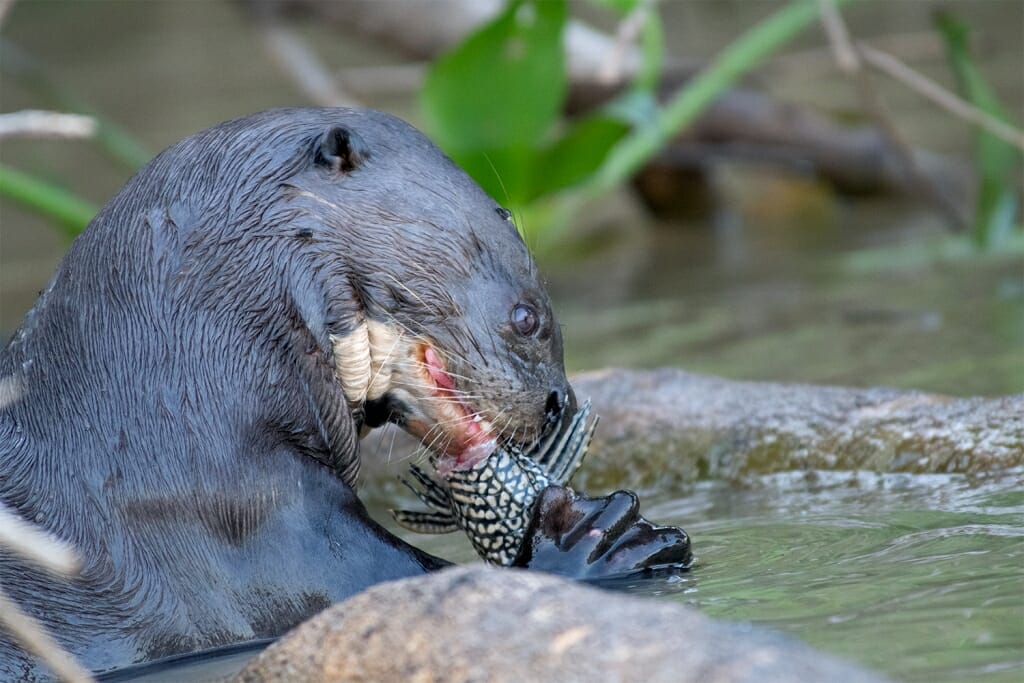
Known through much of its range as the ‘river wolf’ the giant otter is one of South America’s top carnivores. Growing to up to 1.8 meters in length, it is the largest of the otter species.
Sadly, giant otters are also one of the most endangered animals in Brazil. Up until the 1970s, they were hunted for their valuable fur, and at present, they are threatened by habitat loss and pollution. Their habitat is being destroyed by mining, logging and damming of rivers.
As a result, the giant otter is listed as “Endangered” on the IUCN Red List of Threatened Species.
But if you do manage to find them in the wild, giant otters are one of the most entertaining Brazilian animals to watch. They live in social groups, composed of a breeding pair and their offspring that rest, play, fish and sleep together. They seem to exist in the constant state of motion of catching and eating fish.
The best place to see giant otters in the wild is the Brazilian Pantanal, on the banks of the Cuiaba River, around Porto Jofre. We spotted the group in the video above one late afternoon and spent a good half an hour watching their antiques.
By the way, did you know that the collective noun used for a group of otters is a raft? And a raft of otters is not even the strangest name. If you are curious, check out this list of some wonderfully bizarre collective nouns for animals.
Crab-eating Fox
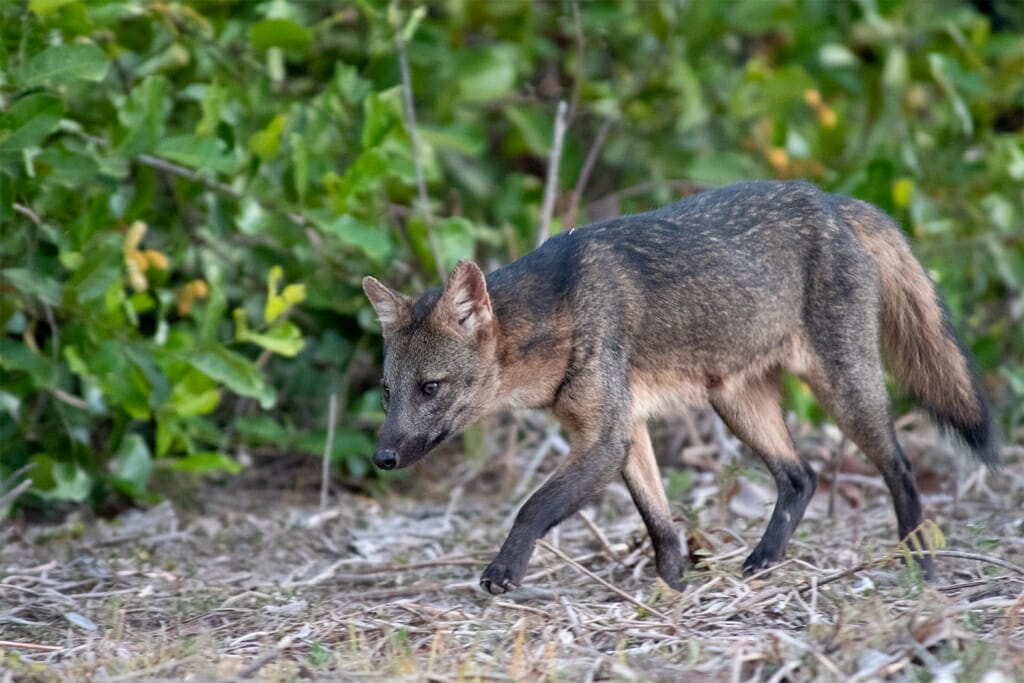
The Crab-eating fox is an attractive canid that is not closely related to true foxes. These animals form monogamous pairs and congregate in small hunting packs that prey mainly on rodents, birds, reptiles and insects. During the wet season, they often search for crabs and other crustaceans on the muddy floodplains, which gives them their name.
They are widely distributed across central and southern Brazil and can be spotted in most forested areas. The Pantanal is one of the best places to see the Crab-eating fox, but there is also a high chance of spotting one of these cute Brazilian animals in most forests and savannas across the country.
Giant Anteater
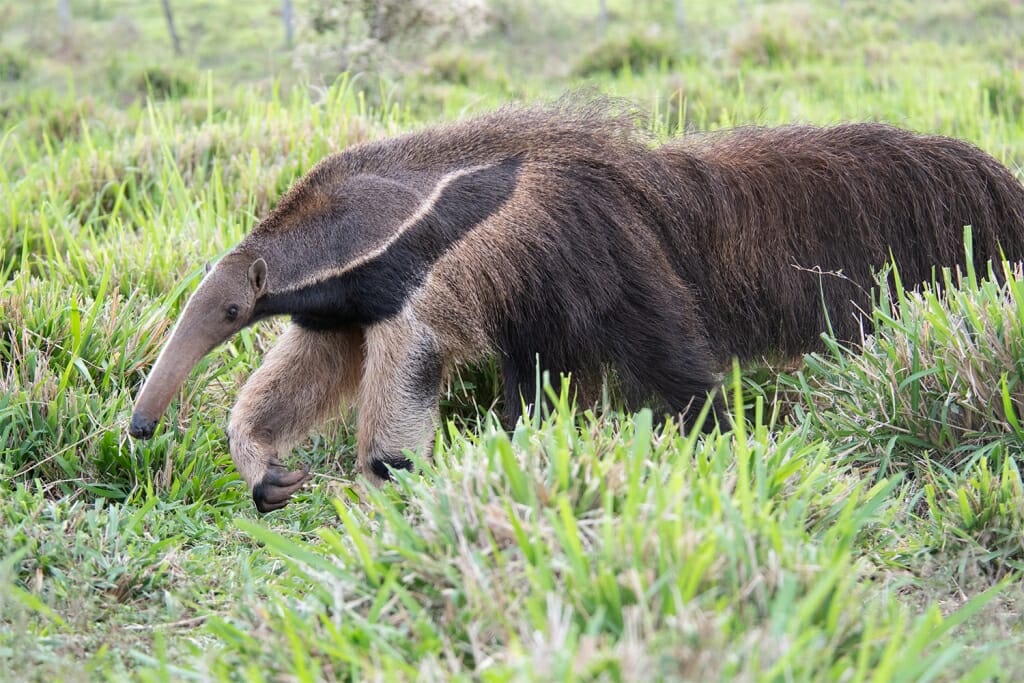
The Giant anteater is one of the oddest-looking animals in Brazil. With its tiny face, long snout, massive body and exceptionally bushy tail, it looks like Mother Nature couldn’t decide what animal it wanted to make.
Threatened by habitat destruction and modification, the giant anteater is listed as “Vulnerable” on the IUCN Red List of Threatened Species. The experts estimate that there are approximately 5000 individuals left in the wild.
As the name suggests, the giant anteater is the largest of all anteaters and can grow up to two meters in length. It is equipped with sharp bear-like claws and a very long tongue – the traits necessary for successfully raiding termite mounds and snatching up insects from their chambers. As the anteater feeds, its tongue shoots out up to 150 times every minute, allowing the animal to consume up to 30,000 insects in a day.
But despite all their adaptations, giant anteaters only take a small number of insects from each nest before moving to the next one, to avoid overexploiting the food sources within their home ranges.
The best place to see giant anteaters in the wild is the Southern Pantanal in Brazil. The open savannah is their preferred habitat type and the abundance of termite mounds guarantees a renewable food supply for them.
Southern Tamandua
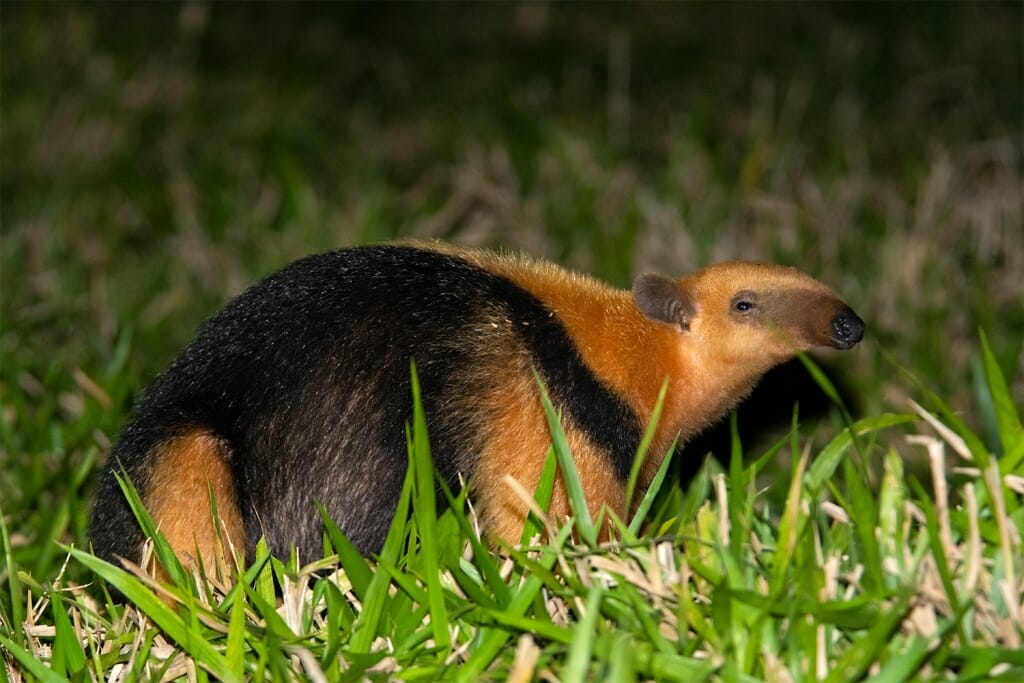
Also known as the Lesser Anteater, the lesser anteater is another odd creature of the Brazilian savannah. Unlike their giant cousins, the lesser anteaters are active mainly at night, spending their days in hollow tree trunks or in the burrows of other animals, such as armadillos.
Like the giant anteater, the lesser anteaters possess long and sharp claws on their feet and walk on the outer surfaces of their front feet to avoid puncturing their palms with the claws. For a human, it would be like walking on your knuckles.
The lesser anteater has a wide distribution range throughout most of South America, and it is listed as “Least Concern” on the IUCN Red List of Threatened Species.
However, despite their wide distribution, the lesser anteater is shy and rarely encountered in the wild. The best place to look for these shy Brazilian animals is Fazenda San Francisco in the Southern Pantanal in Brazil.
Saki Monkey
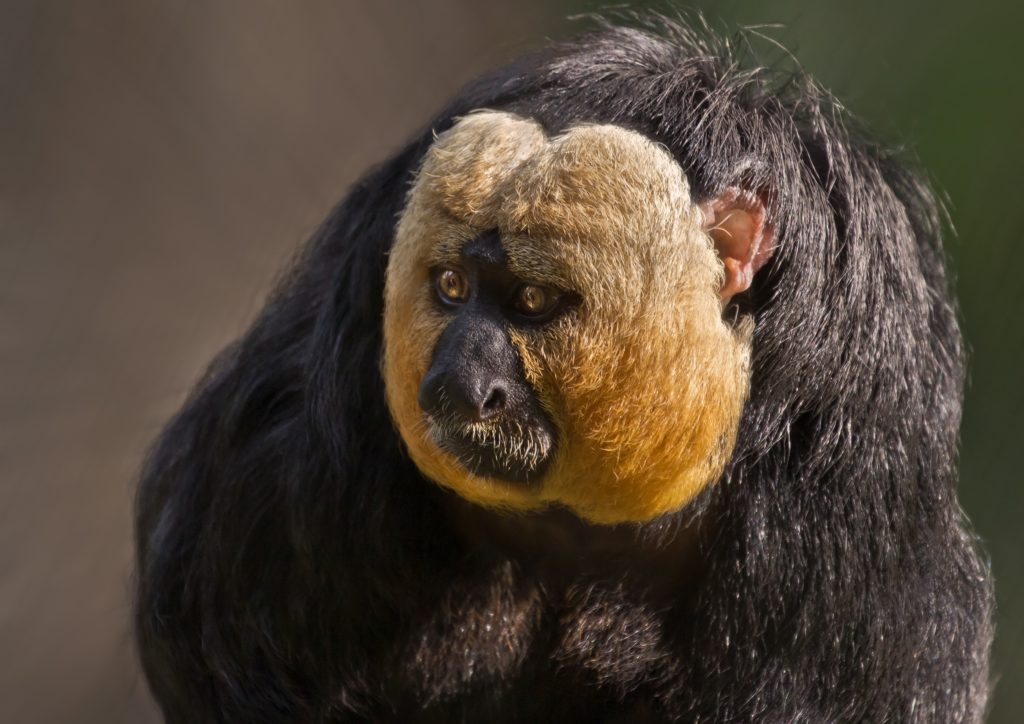
Brazil is beyond doubt, the land of monkeys. There are so many monkeys in the Amazon rainforest alone that scientists are still discovering new species. One of the iconic monkeys of the Amazon rainforest is the White-faced Saki monkey. The name comes from the light-coloured fur on the face of the male monkeys. Female faces are not as exuberant.
These unusual-looking primates live in small groups that can vary from 4 to 12 individuals. Given how thick the Amazon jungle is, you are more likely to hear than to see saki monkeys. The mating pair establishes their bond by singing in duet, their calls filling the forest.
The Amazon is not the easiest place to see wildlife in Brazil. The thick tropical jungle obscures its inhabitants from sight. But if you are determined to see monkeys in the Amazon, a good place to visit is Pousada Rio Roosevelt lodge. It lies deep within the forest and there are no roads leading to the lodge. It can only be accessed by a small plane. But once you are there, you have a chance of spotting 12 different species of primates.
Marmosets
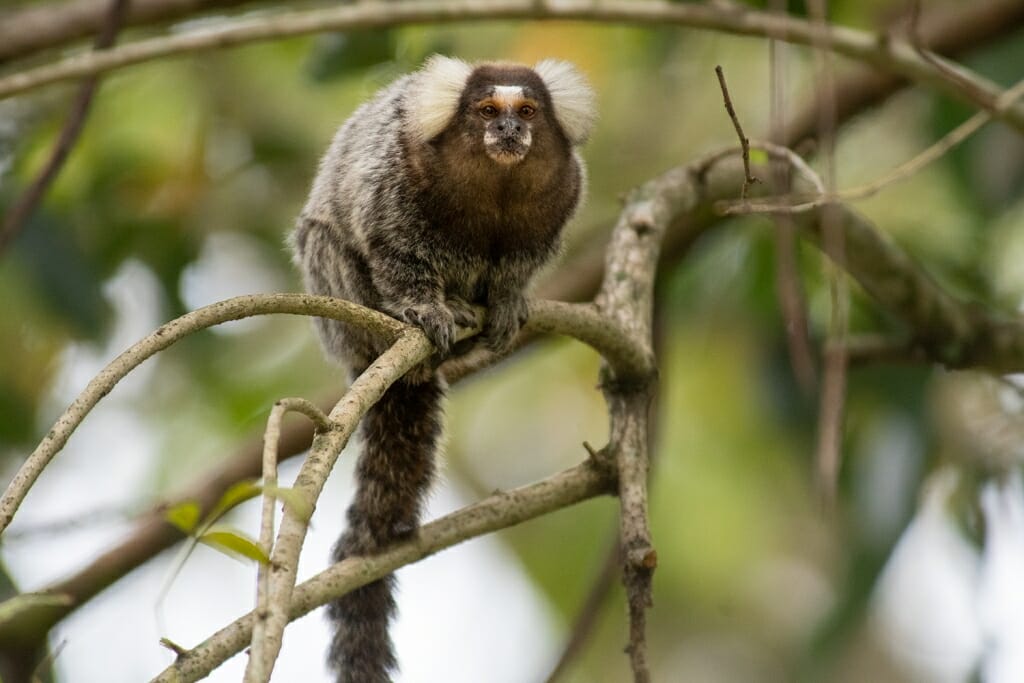
Brazil is home to more monkeys than any other country in the world, and many of Brazil’s monkeys do not occur anywhere else. Of course, just because there are many monkeys around, doesn’t mean that they are easy to see. The smaller primates, like the marmosets, can be particularly hard to spot unless you know where to look. It took us a week in the Pantanal to spot our first Black-tailed marmosets and even then, we only found them because our guide recognized their call.
However, if you do know where to look for them, you can find marmosets even in such major tourist destinations like the coastal town of Paraty and the Botanical Gardens of Rio de Janeiro. At a height of under 20cm and weight of just over 250 grams, marmosets are some of the smallest Brazilian animals and many of them look like tiny Yodas.
Golden Lion Tamarin
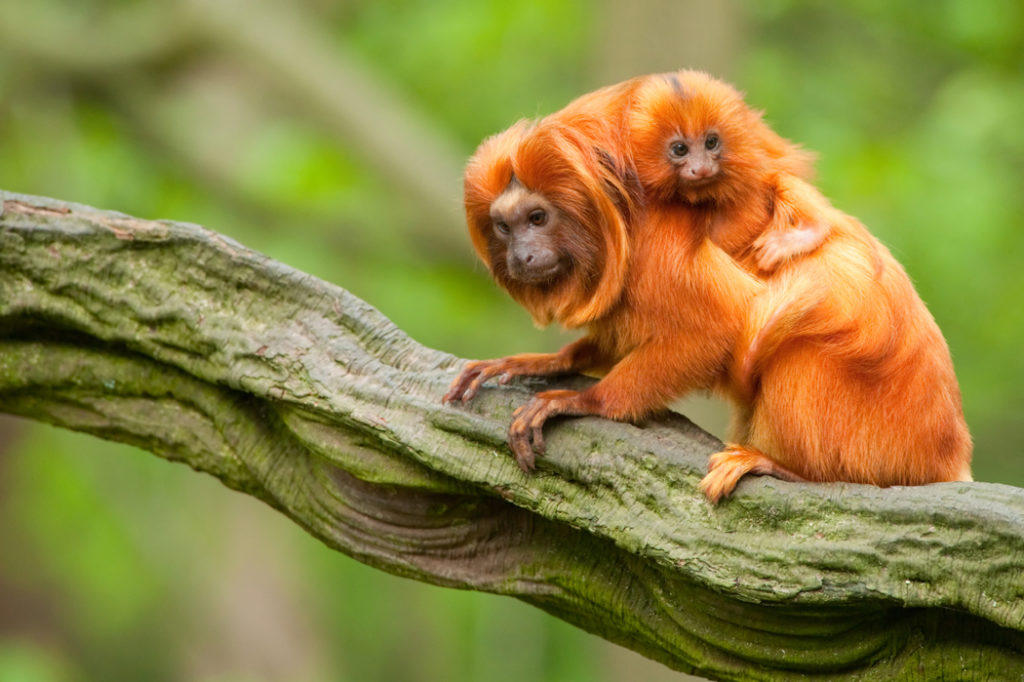
Named for their impressive manes, reminiscent of Africa’s big cat, the Golden lion tamarin is perhaps the most beautiful of all tamarin species. It is an iconic species of endemic wildlife in Brazil and, sadly, one of the most endangered animals of Brazil.
These tiny primates live in social groups in Brazil’s Atlantic coastal rain forests. Unfortunately, these coastal rain forests are where the people like to live in Brazil as well. The giant metropolises of Rio and Sao Paulo replaced the large tracts of Atlantic forest.
This was very bad news for the Golden lion tamarins and by the early 1990s, the species were tittering on the brink of extinction, with about 200 individuals scattered among isolated populations.
Thankfully measures were taken and the first-ever attempt to re-introduce captive-bred animals into the wild habitat was made by the conservation organizations and the disappearing wild population of Golden lion tamarins in Poço das Antas reserve was supplemented by zoo-bred animals. Some of the animals from the unprotected areas were also relocated to União Biological Reserve and Poço das Antas reserve.
After an initial period of trial and error, the wild population started to stabilize and today there are thousands of Golden lion tamarins living in all the reserves and ranches in Brazil. They have become one of the best-known animals from Brazil.
Tufted Capuchin
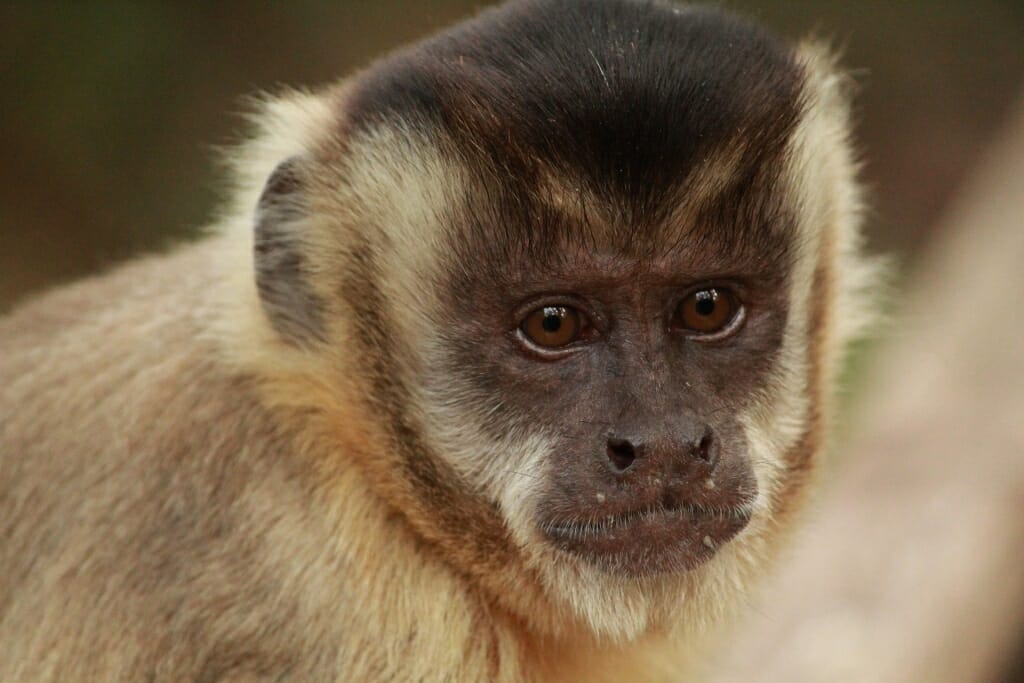
Brazilian Tufted capuchins are the original clever monkeys. They have been observed using more tools than almost any animal apart from chimps and, of course, humans.
They use sticks to get food out of cracks and crevices, rocks to crack open seeds, and sharp stones to dig in the hard soil for roots and fungi. They also have been observed throwing rocks at predators and walking upright on their back feet. And like their relatives, the White-faced capuchins in Costa Rica, they are insatiably curious and will often approach people for a better look.
The Pantanal is a good place to see capuchins in the wild. They are usually heard before they are seen as they often make a racket as they move through the canopy.
We observed capuchins walking on their back legs, like tiny little humans as they emerged from the forest toward a watering hole in the Pantanal.
Three-toed Sloth
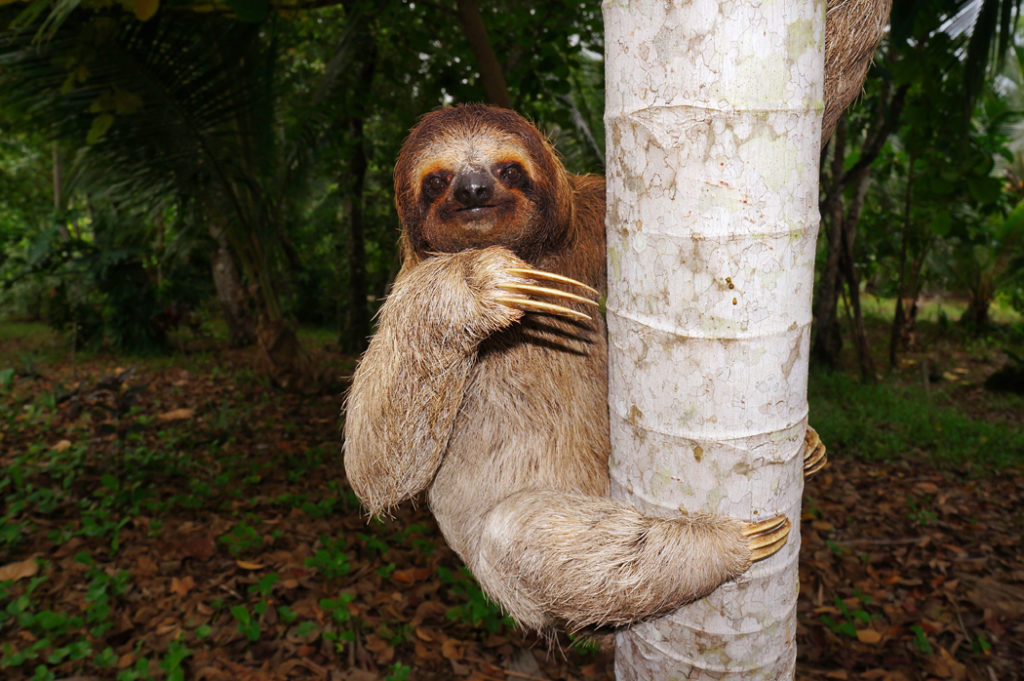
About the size of a small dog, the three-toed sloth is a tree-dwelling animal. Despite appearing slow and clumsy, it is spectacularly well-adapted to the arboreal lifestyle.
Since they never move far from their food supply, they can spend their entire lives in the canopy, hanging upside-down. They eat, sleep, mate and even give birth upside-down. Even their internal organs have shifted to accommodate for their upside-down lifestyle.
Their fur is parted along the stomach and falls from belly to back so that the rainwater can drip off easily. And the shafts of their hair have special groves that house algae. And since they are never in a hurry, algae grow well in their fur and gives it a greenish tint that serves as camouflage against the predators.
Brazil has its very own three-toed sloth – the Maned sloth. It occurs in the Atlantic coastal rainforest in south-eastern Brazil. A good spot to look for the Maned sloth is Monte Pascoal National Park in Bahia.
Yellow Armadillo
Another odd-looking creature, the Armadillo is protected from the dangers of the world by a thick leathery shell. There are 21 different species of armadillo, ranging in size from 150 centimetre-long Giant Armadillo to 15 centimetre-long Pink fairy armadillo.
The Giant Armadillo is very rarely seen in the wild in Brazil. But the smaller Yellow armadillo can be easily seen at Fazenda San Francisco in the Southern Pantanal. Most of the time they are seen on night safaris, but occasionally, they wander to the lodge during the daylight hours, attracted by the corn seed overflowing from the bird feeders.
Brazilian Tapir
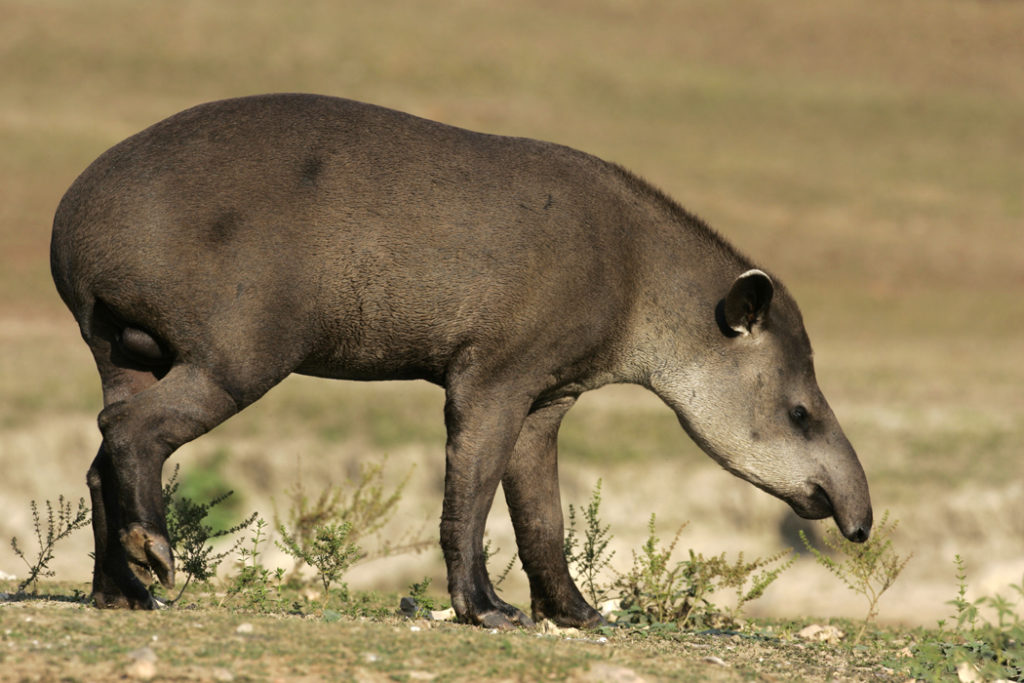
Also known as a South American tapir, the Brazilian tapir is one of five tapir species in the world, all of them are sadly in decline. The Brazilian tapir is threatened by poaching and habitat destruction and as a result, it is listed as “Endangered” on the IUCN Red List of Threatened Species.
These gentle relatives of rhinoceros are herbivores and use their long snouts to grab leaves, shotts and fruit as they brows. They are mostly active at night, retiring under the cover of the forest during the day.
Tapirs are good swimmers and can often be found in or near water. Their feet are equipped with three large toes that help them walk through soggy terrain. In Costa Rica, you can even see the tapirs take a dip in the ocean, in Corcovado National Park.
In Brazil, the Pantanal is the best place to spot the tapir in the wild, particularly the Pouso Alegre eco-lodge, where you can often watch them emerge out of the forest at sundown and wade into a watering hole for a long unhurried drink.
Capybara
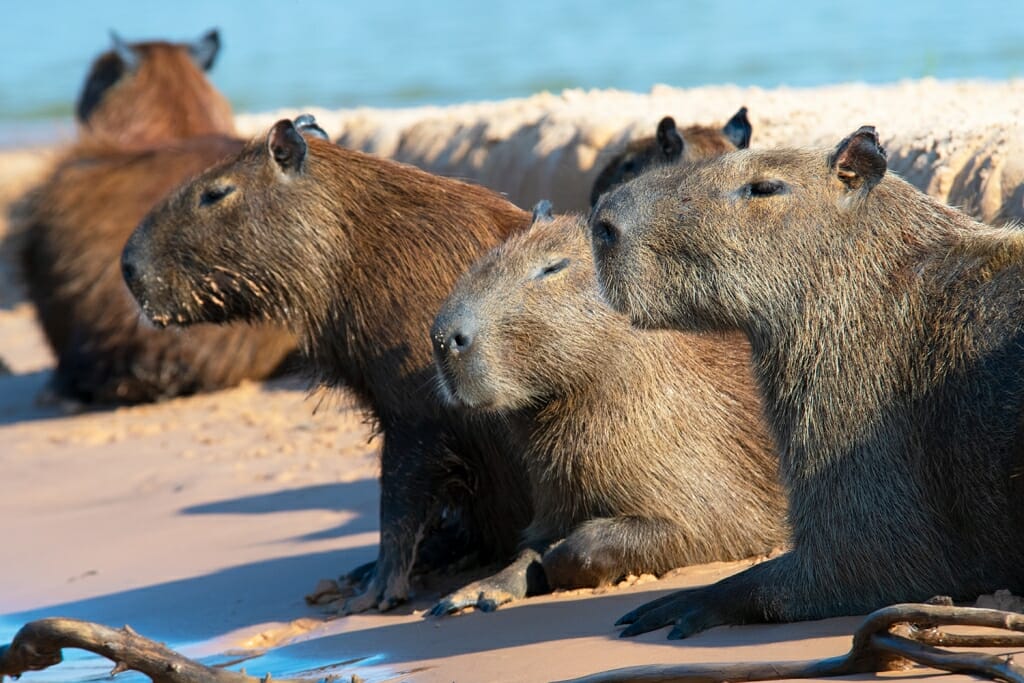
The capybara is one of the most common Brazilian animals. You can spot them even on a taxi ride from Sao Paulo airport to the city. In fact, the largest capybara ever measured was from Sao Paulo. It weighed in at 81 kg (178 lb).
This odd-looking, barrel-shaped animal is the largest rodent in the world and a close relative of the Guinea pig. It is also the favourite prey animal of Brazil’s predators.
A highly social animal, the capybara is often found in groups of 20-30 animals, though some groups can contain up to 100 individuals.
They are semiaquatic animals and superb swimmers, able to hold their breath for up to 5 minutes. Not surprisingly, the best places to see capybaras are the Amazon and the Pantanal.
Azara’s Agouti
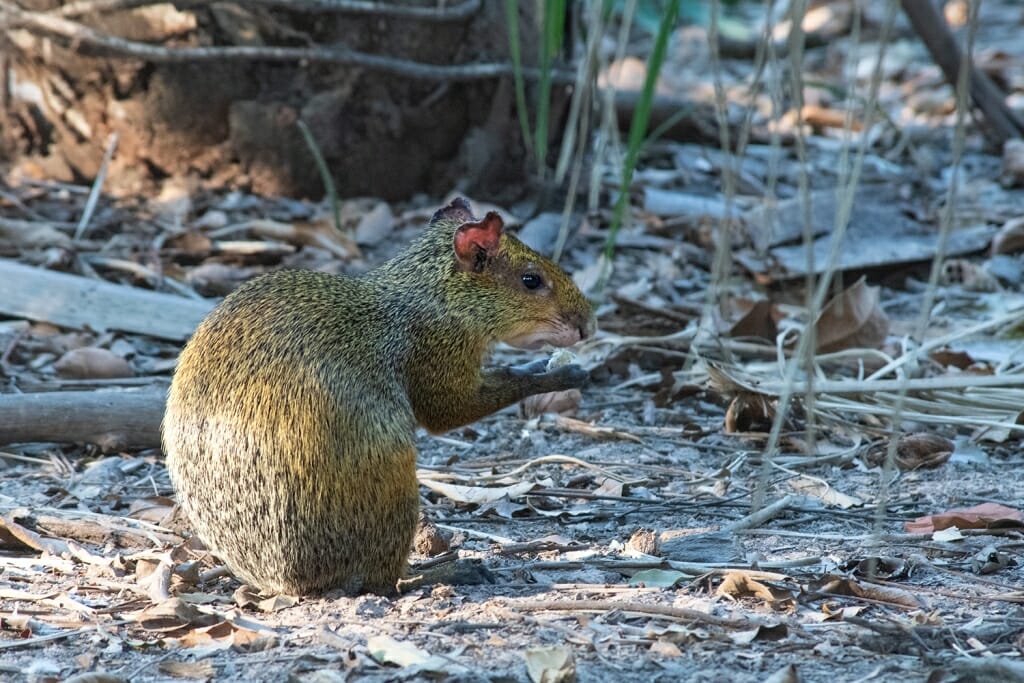
Looking like a tiny deer, the dainty Agouti is actually a rodent, closely related to guinea pigs. They are one of the shiest wild animals in Brazil and are not often seen. Weighing no more than 3 kg, they scurry around the forest floor really venturing out into the open.
Much like the red squirrels in Europe, Azara’s agoutis are accidental gardeners – they often bury nuts and seeds and then forget where they put them, leaving the seeds to germinate and grow into new trees.
They also have a squirrel-like manner of feeding – sitting on their haunches and holding food between their forefeet. A good place to see them is the Pantanal, as well as the Atlantic forest, including Iguazu Falls.
South American Coati
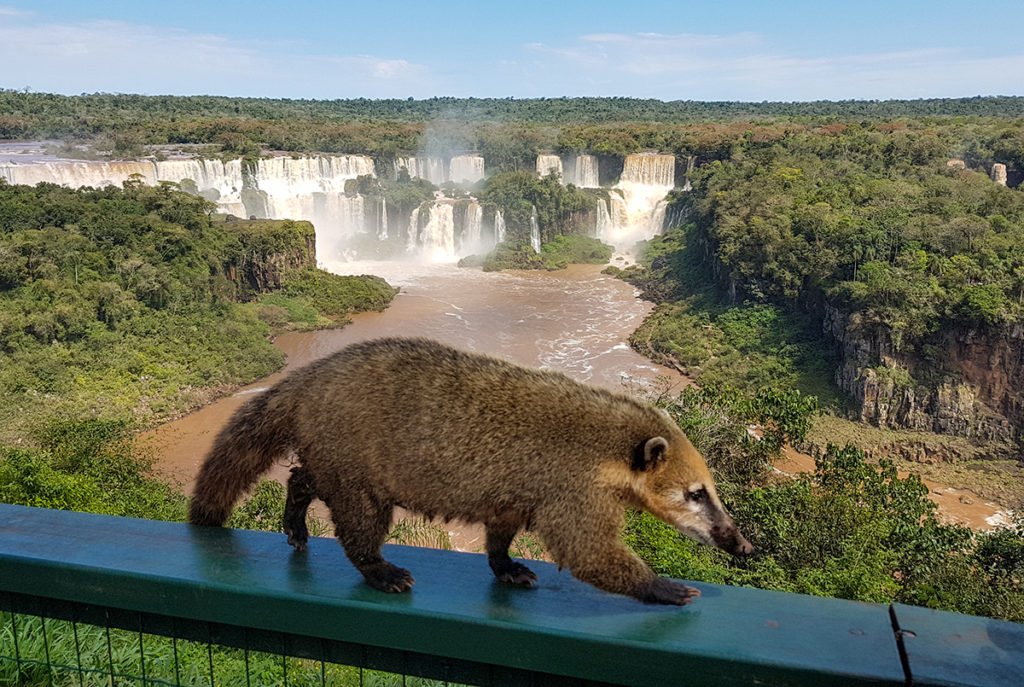
Looking like a cross between a raccoon and a ring-tailed lemur, the Coati is Brazil’s answer to meerkats. They belong to the raccoon family and like raccoons, they eat just about anything. Coati is one of the most commonly encountered species of wildlife in Brazil, mostly because they easily become accustomed to people and can often be seen around popular tourist attractions.
Like their Central American cousins, the White-nosed coatis, they spend a large amount of time foraging on the forest floor holding their long tails up. You can see coatis in the Pantanal and at Iguazu Falls where they became quite problematic for their dependence on tourists for food.
Collared Peccary
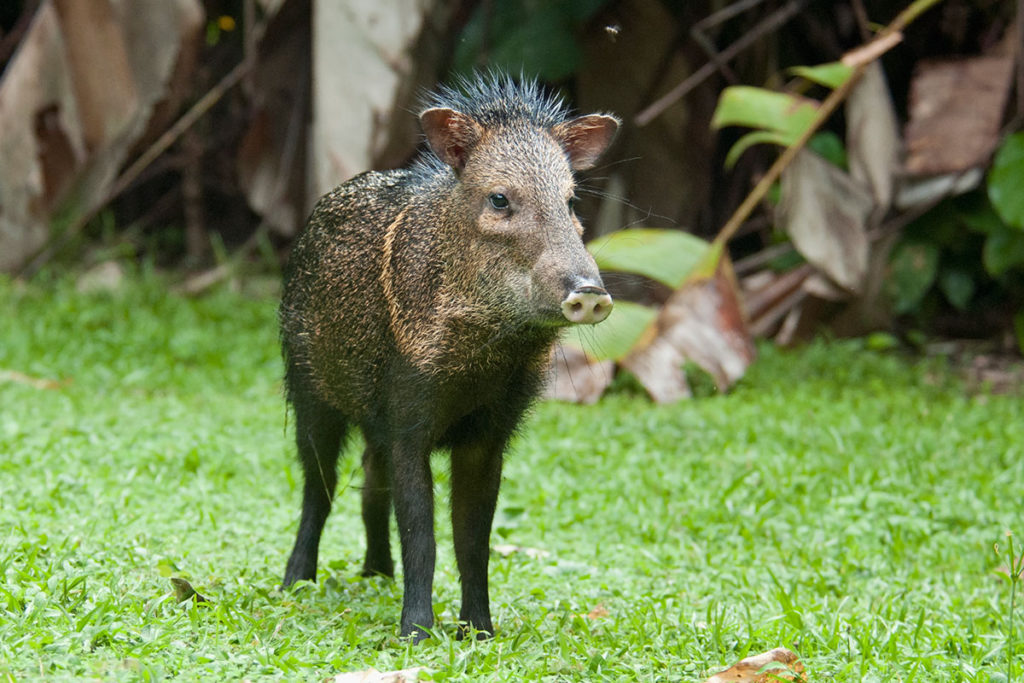
While they look like wild boars, peccaries are not pigs. They belong to a family of their own. Collared peccary is the smallest family member, measuring around 50-60 centimetres (20–24 in) at the shoulder and weighing between 16 and 27 kg (35 and 60 lb).
Peccaries are social animals that live in herds of about 15 individuals and spend their days looking for succulent plants, small lizards and insects in the grass.
You can see them across Brazil, including the Pantanal and cerrado habitats.
Red Brocket Deer
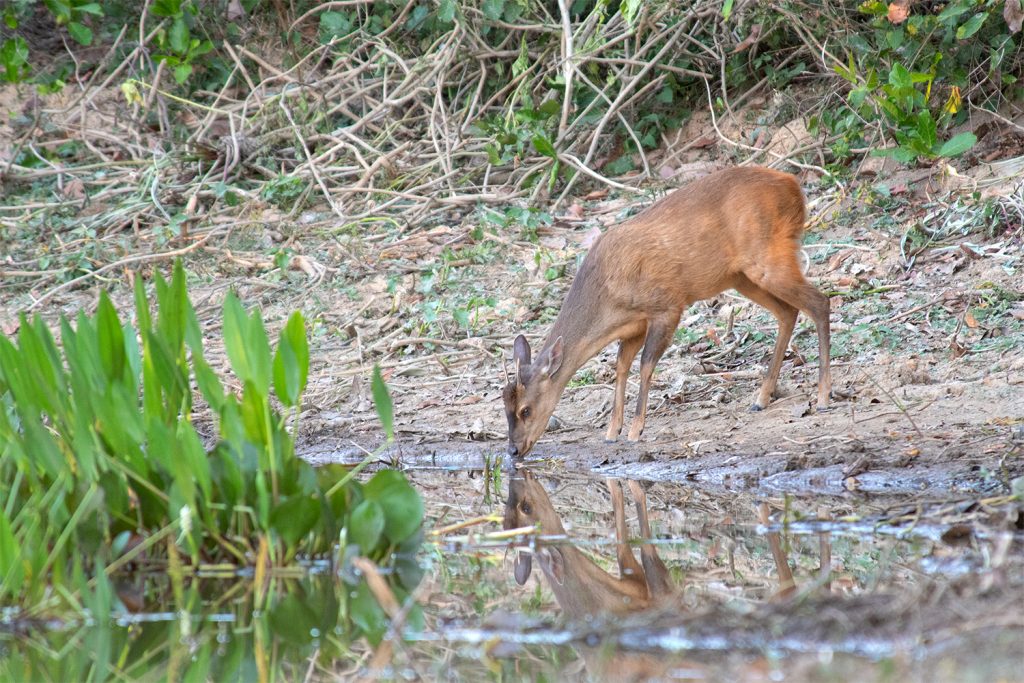
Broket deers are a family of small to medium-sized deer native to Latin America. The largest of broket deer species is the Red broket deer. Although despite this status it is still a rather demure deer, growing to around 67 to 80 centimetres (26 to 31 inches) at the shoulder, and weighing between 24 and 48 kilograms (50 to 100 pounds).
Because it is one of the favourite prey species for predators like jaguars and pumas, it is quite a shy animal that tends to retreat at the slightest disturbance. So while they have quite a wide distribution range in Brazil they are not often easy to see.
Pantanal is a good place to watch them in the wild. More heavily trafficked areas, like the Iguazu Falls, are also a possibility, although you are more likely to see a retreating back end than have a chance to observe the animal going about its business.
Marsh Deer
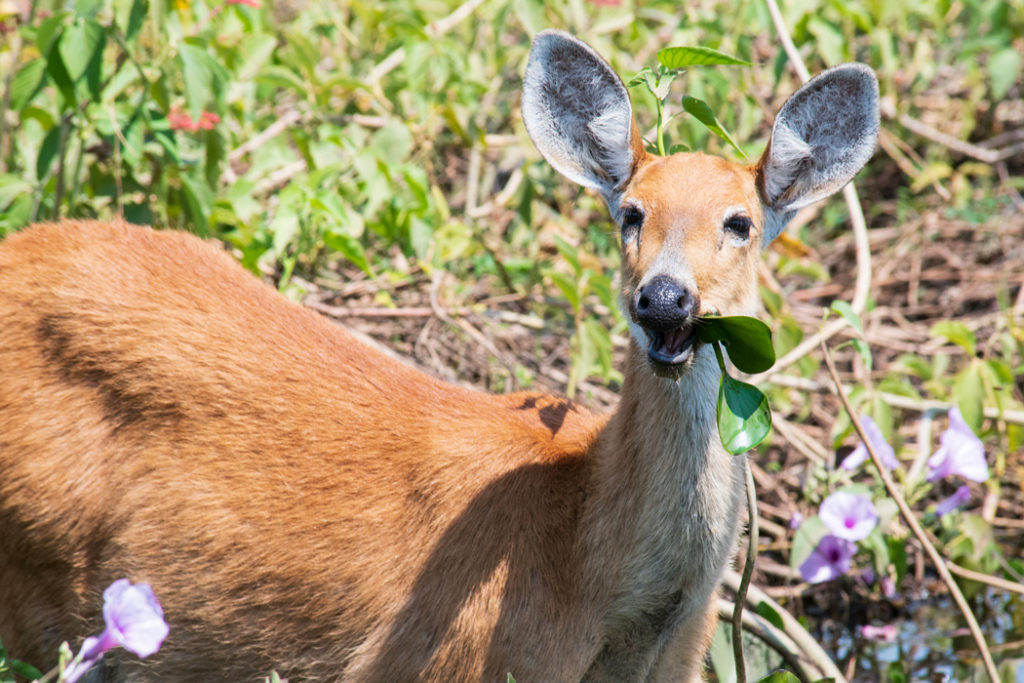
Here is the largest deer species in South America. Also known as swamp deer (not to be confused with Barasinga swamp deer in India), marsh deer stands up to 1.2 m (3.9 ft) at the shoulder. Previously an abundant species across its range, today marsh deer are restricted to small populations and listed as Vulnerable on the IUCN Red List of Threatened Species.
One of the reasons for the marsh deer decline is their dependence on marsh areas like the Chaco and Pantanal in Brazil. As more marshes are drained to convert the land for agriculture, the deer’s habitat disappears at an alarming rate.
Marsh deer are some of the best swimmers among Brazilian animals and feel comfortable wading chest-deep in the water feeding on aquatic vegetation.
Macaws
Macaws are beautiful, brilliantly coloured members of the parrot family. The magnificent Hyacinth macaw is the largest macaw and the largest flying parrot in the world, reaching 100 centimetres in length.
Because of their striking looks, Hyacinth macaws are popular in the exotic pet trade. The capture of birds, together with habitat loss are the main causes of these magnificent birds’ decline. They are listed as “Vulnerable” on the IUCN Red List of Threatened Species.
However, despite the decreasing numbers, Hyacinth macaws can be easily spotted around Porto Jofre in the Northern Pantanal. They like to feed on the low-hanging fruit of palm trees, which means that you can often watch them at eye level.
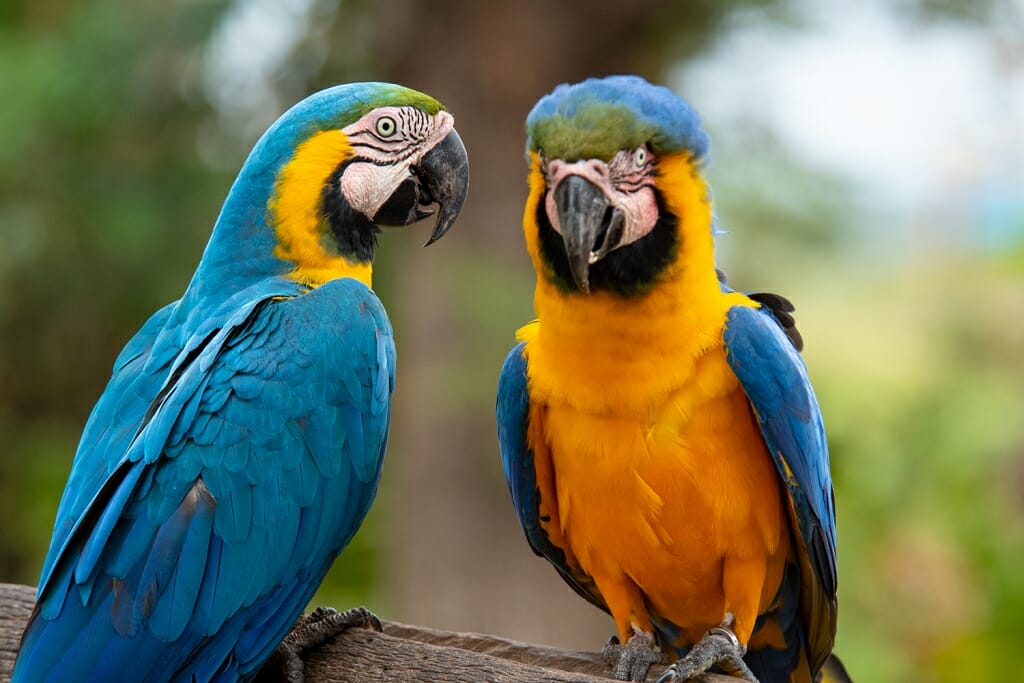
Another macaw that can be spotted in the Pantanal is the Blue and Yellow macaw. One of the best places to see this species is Fazenda San Francisco.
Parrots
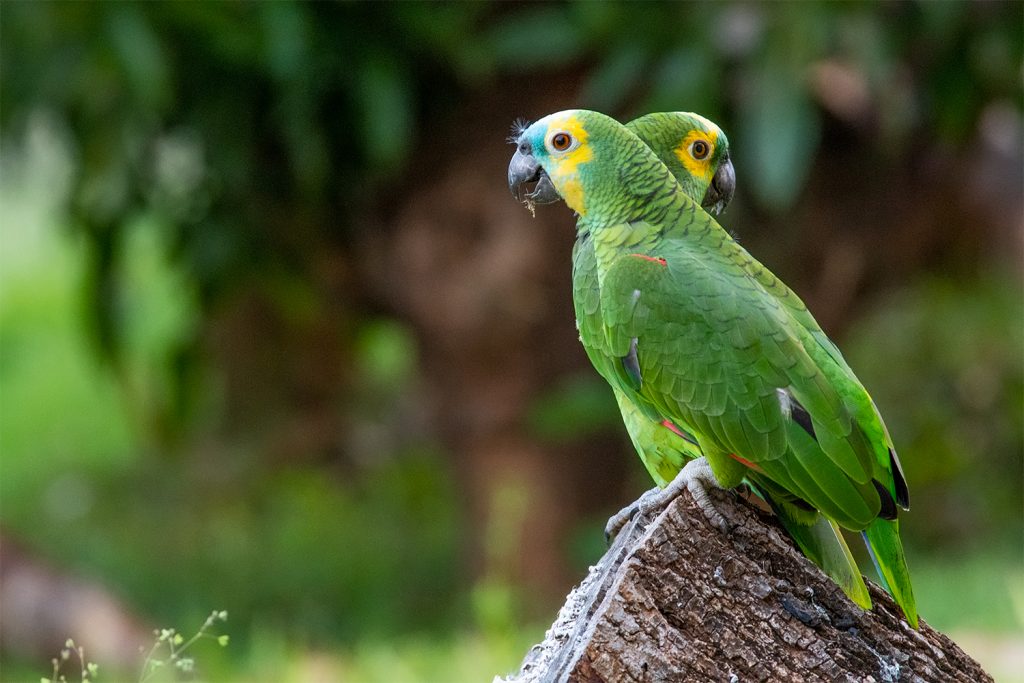
Brazil is home to an incredible variety of parrots and they can be seen almost anywhere you go in Brazil. Monk parakeets are some of the most common parrots in the country. Blue-fronted parrots, Yellow-chevroned parakeets and Peach-fronted parakeets are common in the Pantanal.
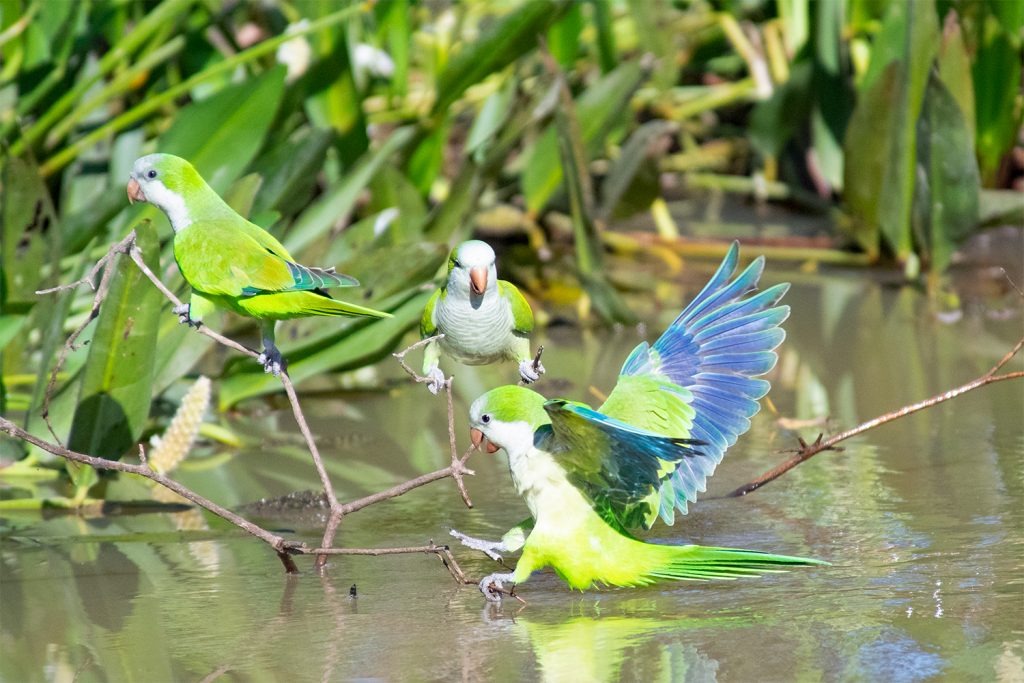
There is an entire genus of Amazon parrots. Although not all of them occur specifically in the Amazon: Red-spectacled amazon, Red-browed amazon, Red-tailed amazon, Festive amazon, Kawall’s amazon, Yellow-winged amazon and Vinaceous-breasted amazon.
In the cerrado habitat, the Yellow-faced parrot is fairly common. The best place to look for them is Emas National Park.
Toucans
As a bonus, here is another fascinating family of Brazilian wildlife that you will likely encounter on your travels – the toucans. All birds in this family feature spectacularly oversized and often colourful beaks.
It is not known exactly why these birds evolved to have such an extravagant appendage, but one of its benefits is the all-important energy conservation. Feeding primarily on fruit, the toucans can park themselves in a fruiting tree and reach the faraway fruit from their perch without the need of hopping around.
The most common toucan in Brazil is the Toco toucan. It can be found in the Pantanal, at Iguazu Falls and along the eastern coast, near Rio and São Paulo.
Araçari.
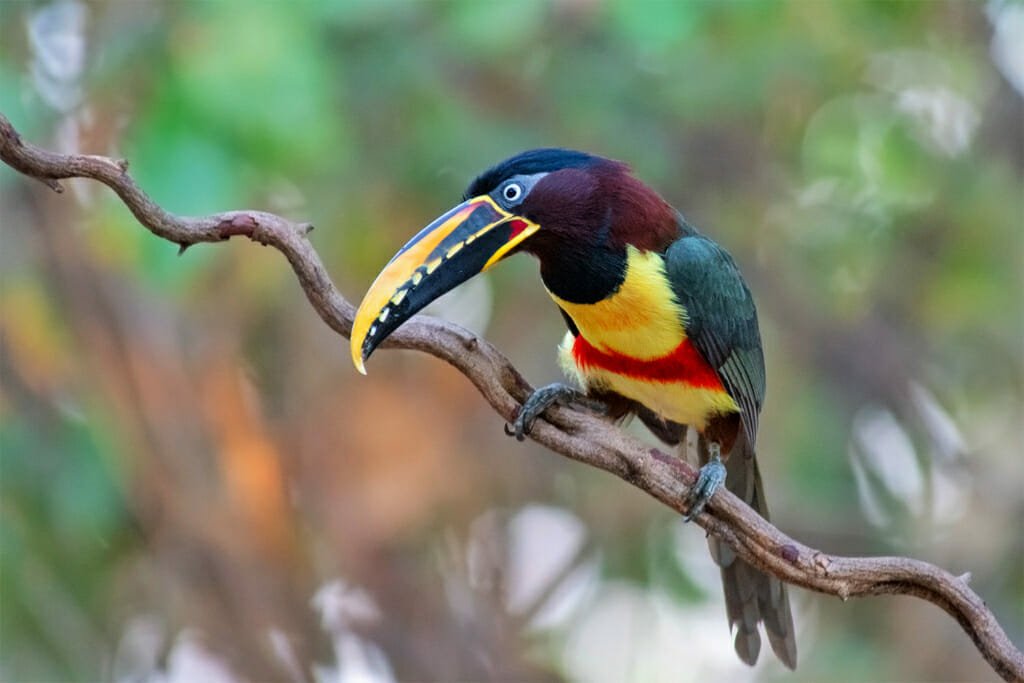
Aracari is closely related to toucans – they are also known as toucanets. Just like toucans, aracaris have magnificent beaks, but some aracaris are even more colourful than their better-known cousins.
One of the most striking members of the family is the Chestnut-eared araçari. It is also quite widespread, but the best place to see it is the Northern Pantanal.
Rhea
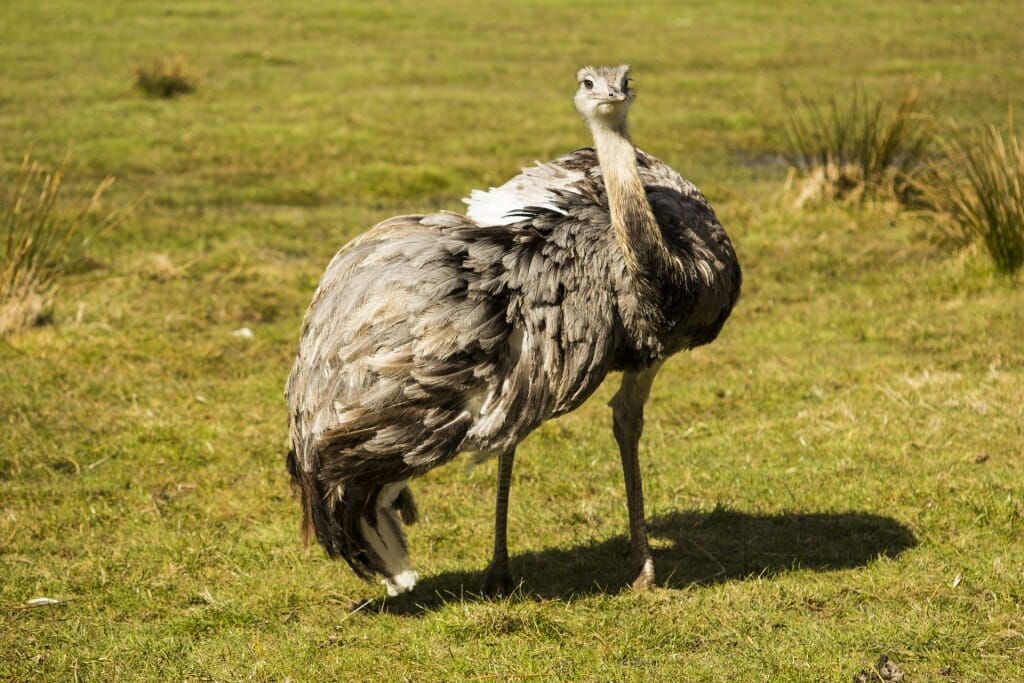
Rheas are large, flightless birds, similar to the African ostrich and Australian emu. Unlike most birds, rheas tend to be silent apart from the time when the male is seeking a mate. During the breeding season, the male emits a loud booming call that female rheas find irresistible.
Curiously, in Greek mythology, Rhea was the mother of the gods, and goddess of female fertility and motherhood. Yet in the bird world, rheas are not exactly mothers of the year.
It is the male that builds a nest and courts the females to lay eggs for him. Once the eggs are laid, male rhea will either incubate them or recruit a subordinate male to incubate the clutch while he builds another nest and courts more females.
Tanagers
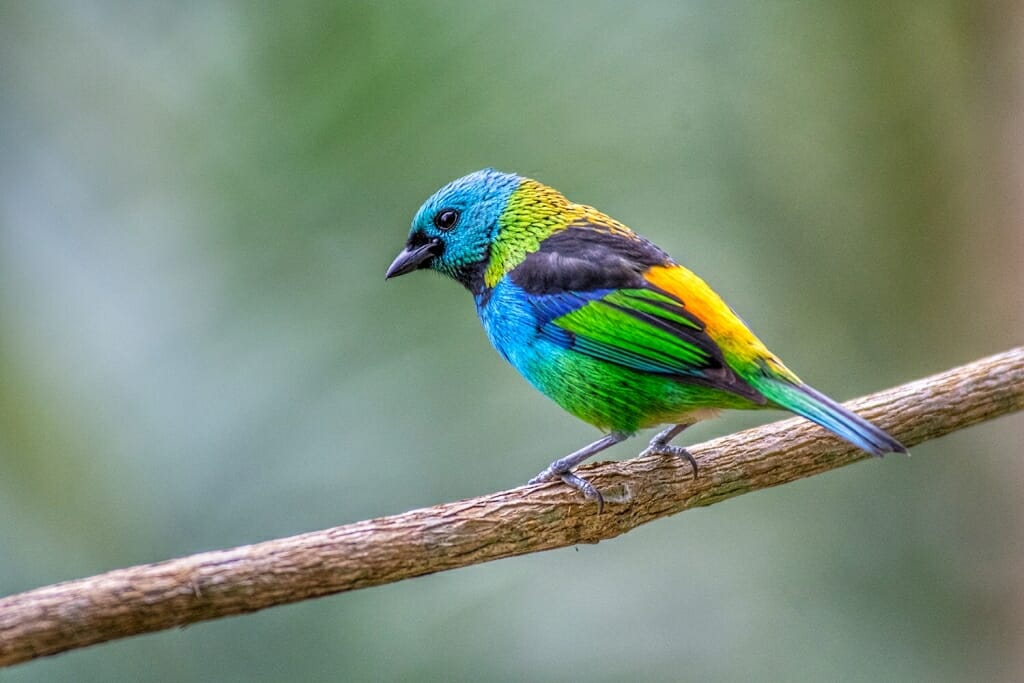
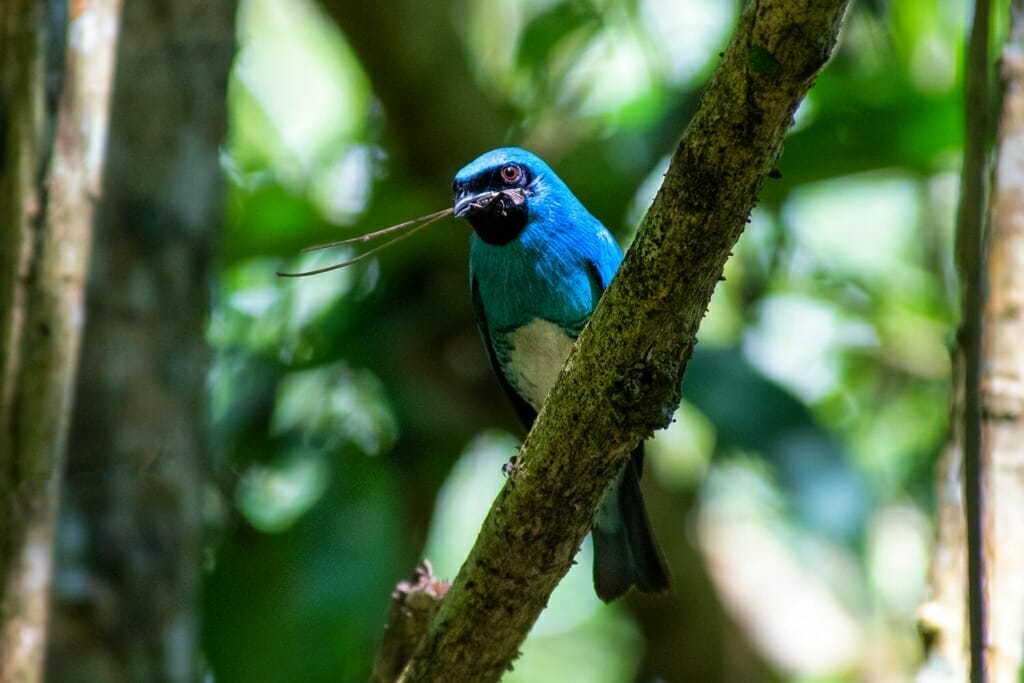

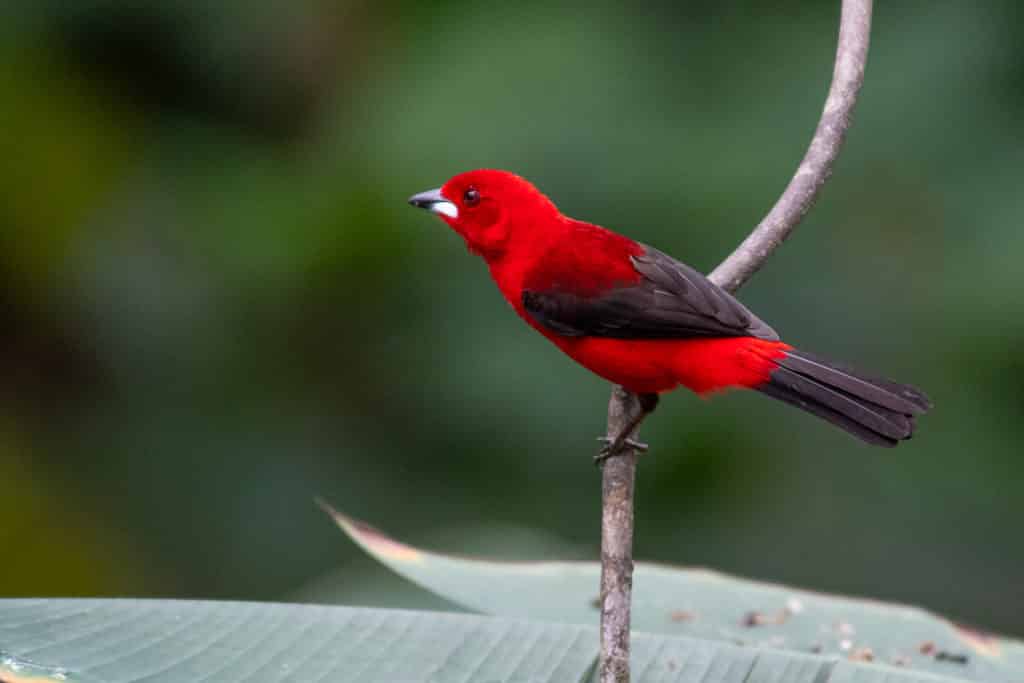
Tanagers are some of the most brilliantly coloured birds in Brazil. They come in all colours of the rainbow. There are red Brazilian tanagers, Blue-grey tanagers, bright blue Swallow tanagers, Turquoise tanagers, vividly multicoloured Paradise tanagers, Bay-headed tanagers and Green-and-Gold tanagers.
Tanagers are the second-largest family of birds and represent about 4% of all bird species in the world and 12% of all Neotropical birds.
Most tanagers are omnivorous feeding on fruit, nectar and insects. They live in pairs or in small family groups of three to five individuals consisting of the mating pair and their offspring.
You can spot tanagers almost anywhere. One of the best places to see a good variety of species is the Atlantic forest near the coastal town of Parati.
Hummingbirds
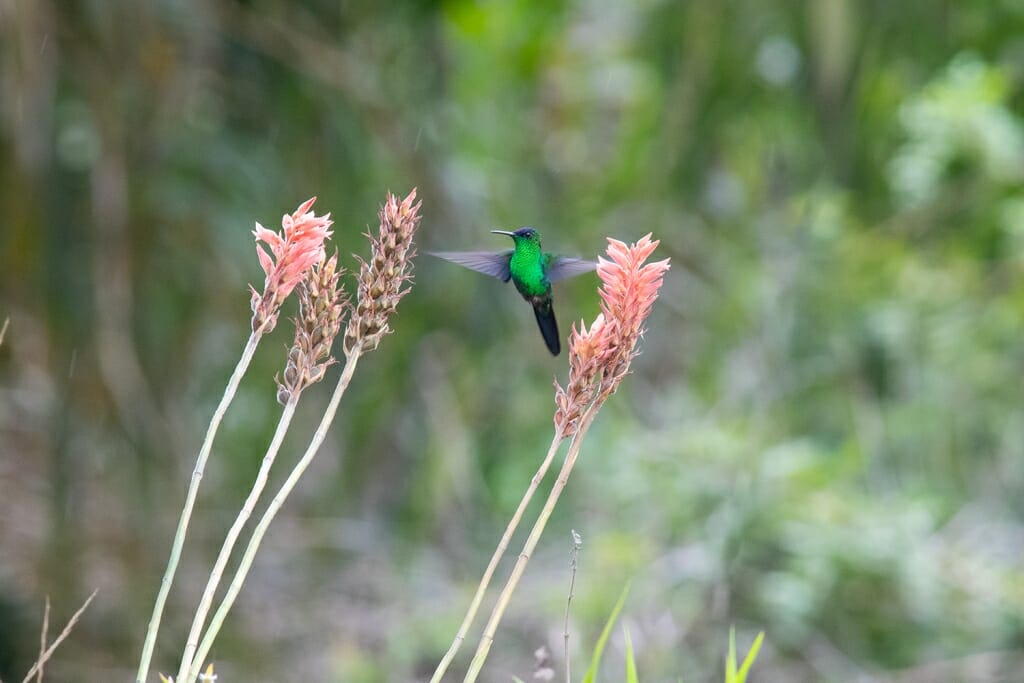
On the opposite end of the size, scale are the Hummingbirds, Brazil’s smallest birds. There are a few species of hummingbirds in Brazil, particularly in the Atlantic forest, and none of them grows to more than 13 cm in length.
The name hummingbird comes from the humming sound created by their flapping wings. As the birds hover in mid-air, their wings move so fast (up to 80 flaps per second) that the human eye is unable to discern individual flaps. All we see is a fuzzy blur.
To compensate for such an extraordinary expenditure of energy, the hummingbirds go into torpor, a state similar to hibernation, each night.
One of the best ways to see the Hummingbirds in Brazil is to join a birdwatching tour to the Atlantic rainforest around the coastal town of Paraty, a popular holiday destination not far from Rio.
Roadside Hawk
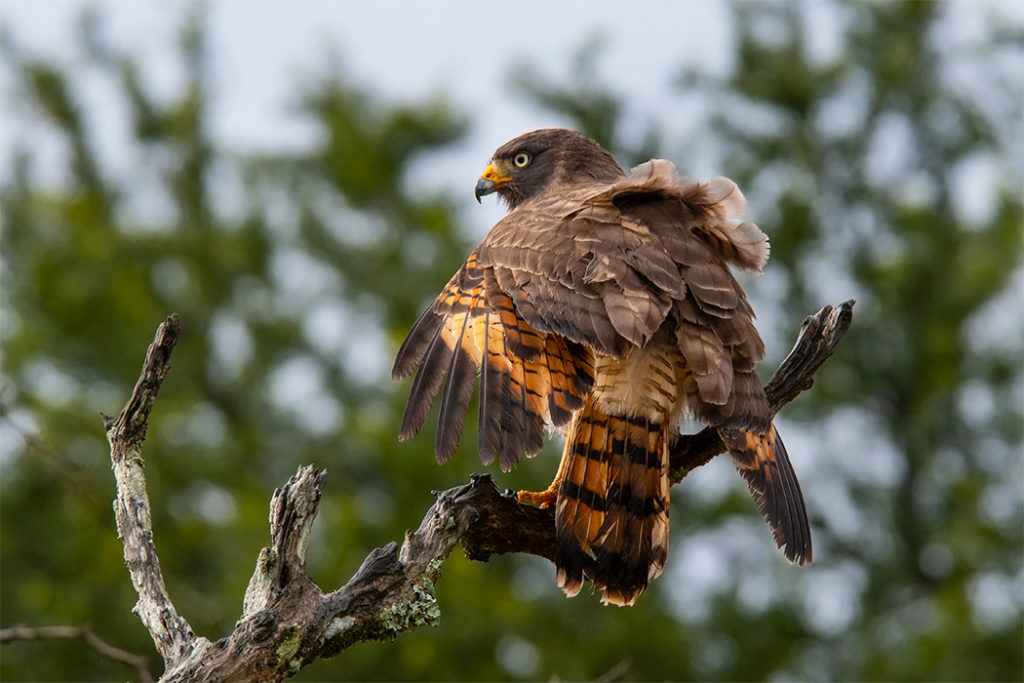
Brazil is home to an incredible diversity of birds of prey. From the magnificent Harpy eagle to the dainty American kestrel, these birds are some of the most interesting creatures to see in the wild. And while Harpy eagles may be incredibly difficult to track down, there are plenty of other birds of prey to observe.
One of the most common feathered predators is the Roadside hawk. It can be spotted sitting alone on top of the bushes and small trees in the open areas and at the forest edge.
It feeds on a variety of small prey including reptiles, small mammals, and birds, but the majority of the roadside hawk’s diet is made up of insects.
It is one of the easiest birds of prey to see in Brazil, and a good place to look for it is, yes, you guessed right, in the roadside trees and bushes.
Yacare caiman
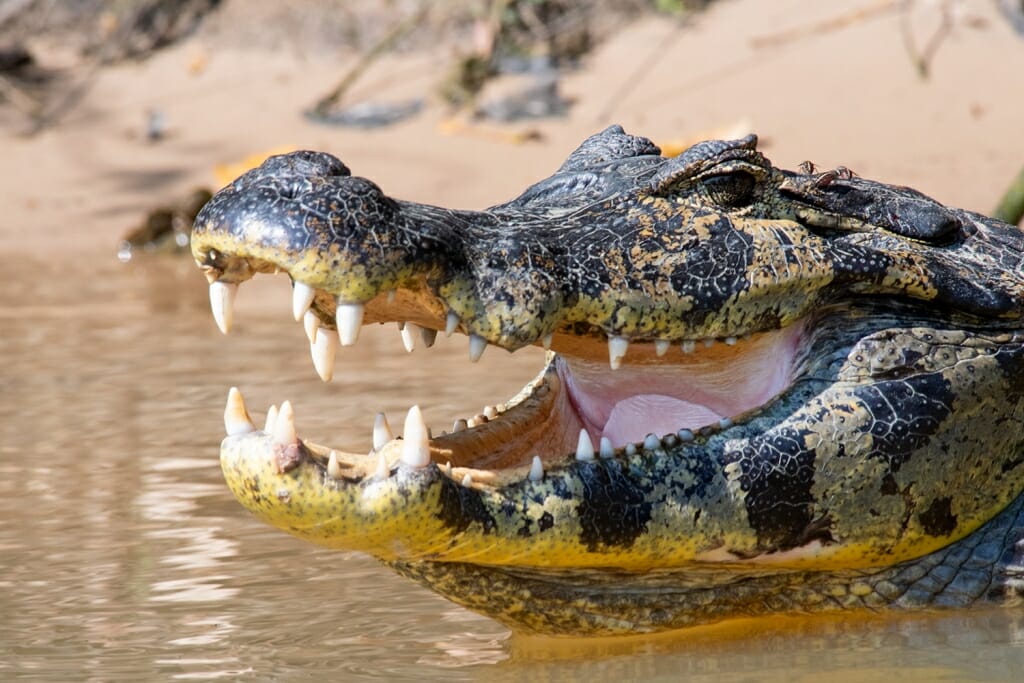
If you visit the Brazilian Pantanal, you will think that Yacare caiman is the most abundant species of Brazilian wildlife. Hundreds of these crocodile-like reptiles bake on the riverbanks and lurk in the muddy waters of marshes and streams. But by the 1980s the caimans were hunted almost to extinction.
Unlike the Australian saltwater crocodiles, that habitually kill humans, the smaller Yacare caimans are not dangerous to humans. They feed mainly on aquatic invertebrates, like snails, and fish.
Thankfully, the trade of wild crocodilian skins was finally banded across the globe in 1992 and Yacara caimans came back with a vengeance. The current combined population in Argentina, Bolivia, Brazil and Paraguay numbers approximately ten million individuals. However, poaching is still a problem in many of these countries.
Green Anaconda
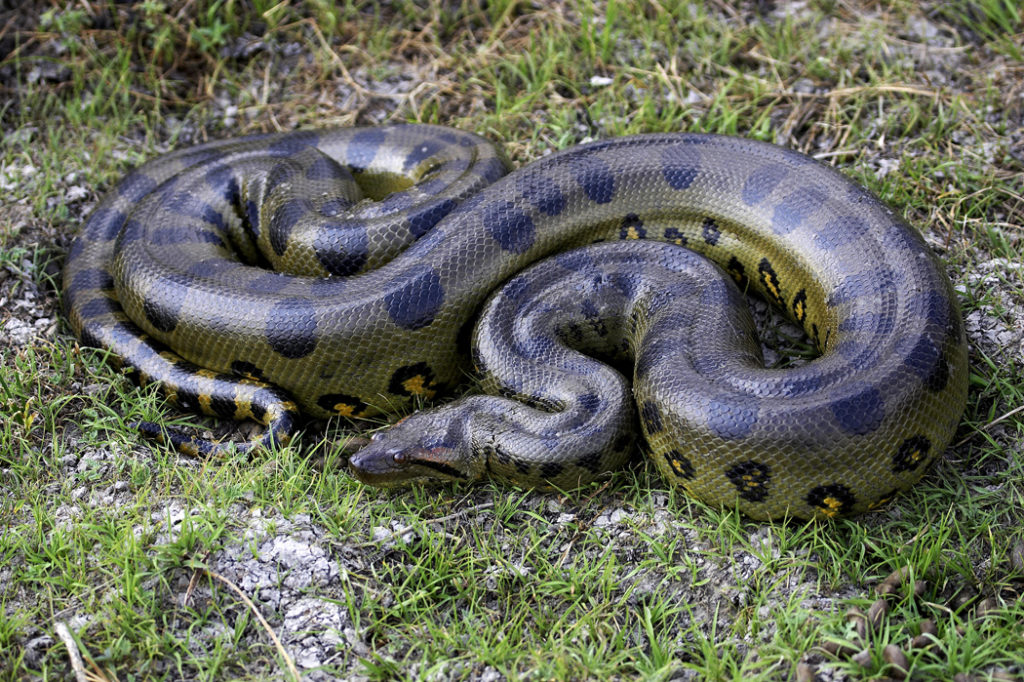
Another creature with a sinister reputation is the Anaconda – the largest snake in the world and one of the most dangerous Brazilian animals. Technically, Asia’s reticulated python is longer, but the Anaconda packs a lot more bulk. Females tend to be significantly larger than males. The longest and heaviest female Anaconda on record measured 5.21 m long and weighed 97.5 kg.
These giant reptiles live in swamps, marshes and slow-moving rivers and ambush their prey much like the crocodiles. They float beneath the surface of the water with only their snouts resting above the surface. Their eyes and nostrils are positioned on the top (rather than on the sides) of their heads to accommodate their aquatic lifestyle.
When their prey stops for a drink, the anaconda strikes and coils around it with its body. Once it has a good grip, the snake slowly constricts its hold until the prey suffocates. Like all boa constrictors, the Anaconda then swallows its prey whole and spends a couple of weeks digesting it.
For your best chance to spot the Green Anaconda in the wild, head to the Amazon rainforest.
Fer-de-Lance
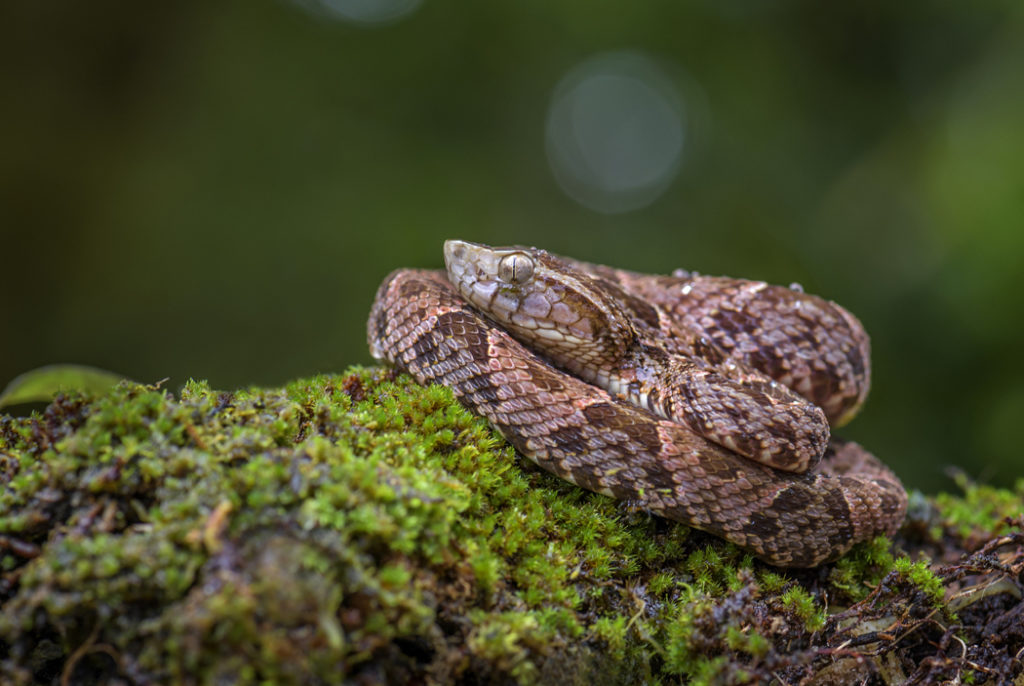
Fer-de-Lance is one of the most venomous pit-viper species in South America and one that causes the most snake-bite related mortalities. So if you are looking for one of the most dangerous Brazilian animals – this is it. Its perfect camouflage, defensive temperament, and its tendency to live near human settlements are the main reasons that it comes into conflict with people and is considered one of the most dangerous Brazilian animals.
Fer-de-Lance is a nocturnal snake. It spends its days basking in the sun and it’s nights lying in ambush, perfectly camouflaged among the leaf litter, waiting for its prey to approach within striking range.
Green Iguana
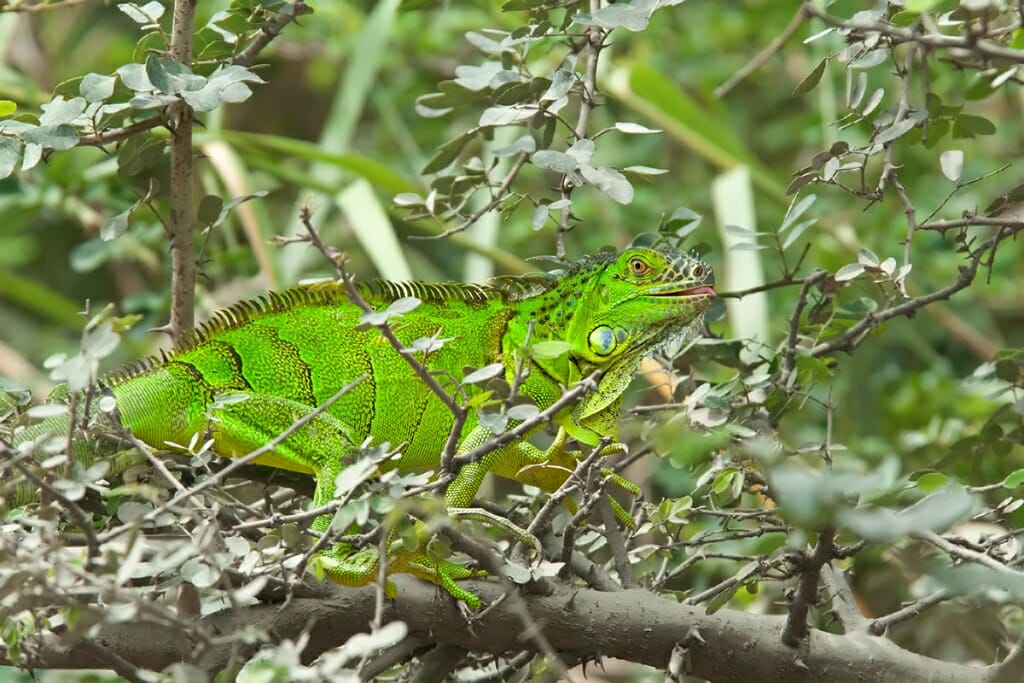
One of the most conspicuous lizards in the Americas, the Green Iguana is a large terrestrial lizard that is active during the day. It feeds on fruit, leaves and flowers.
Iguanas generally live near water and they are excellent swimmers. Like many other lizards, Iguanas can detach their tails to avoid predation. However, if getting away is not an option, they will use their razor-sharp teeth and sharp tails that they can swing as a whip to defend themselves.
Poison dart frogs
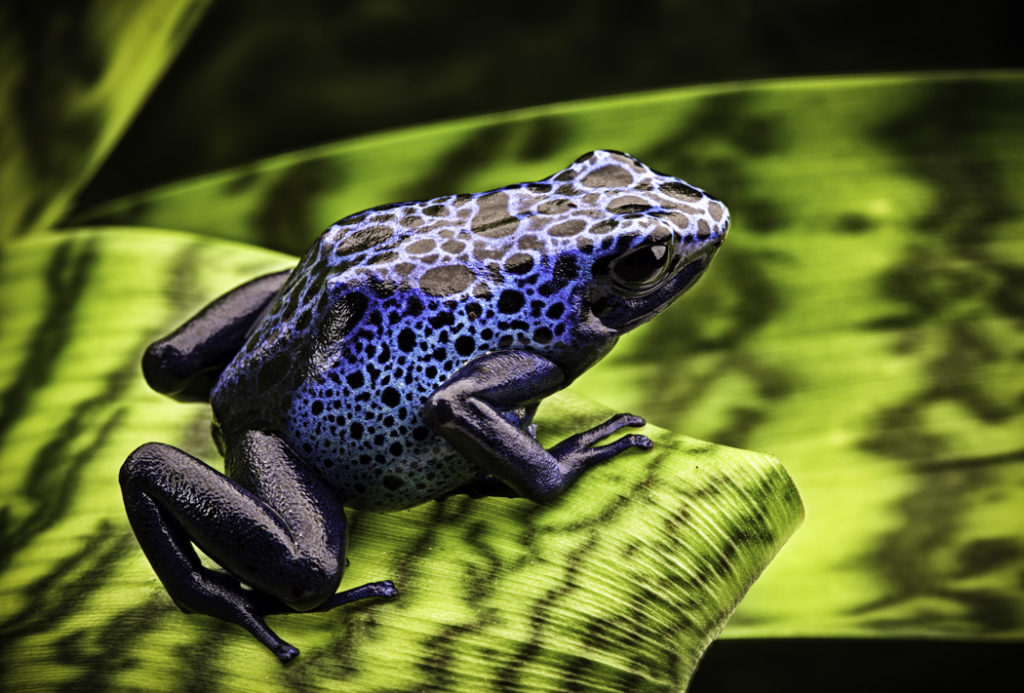
The poison dart frogs are some of the most colourful Brazilian animals on the rainforest floor. Most of them are tiny, no bigger than your thumbnail and can sometimes be tricky to find. Thankfully, like all frogs, they are highly vocal and their calls will give you a clue where to look for the animals themselves.
Occasionally, they will be calling out in the open – sitting on plant leaves or rocks, but more often they will conceal themselves on the forest floor among the leaf litter. This is where their bright colours come in handy – a bright blue tiny blob will stick out against the dark background of dead leaves and twigs like a sore thumb.
Most Brazilian poison dart frogs, like the Blue poison dart frog and Brazilian endemic Brazil-nut poison frog, occur in the north of the country. The best place to look for them is the Amazon rainforest.
Piranha
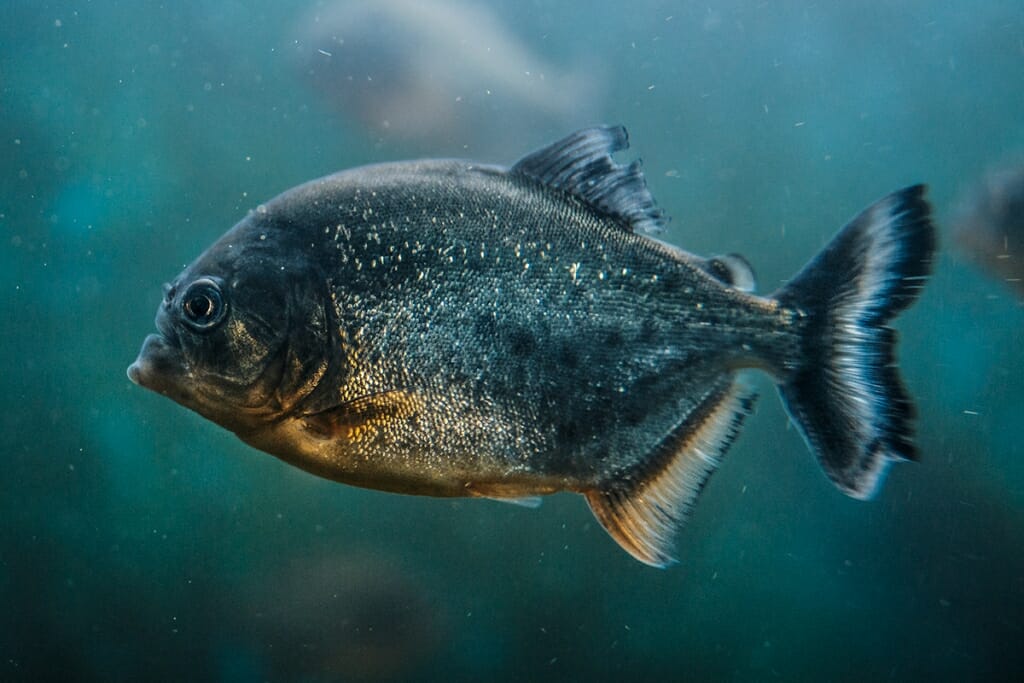
The piranha often gets the bad rap as a ferocious flash-eater. Of all the wildlife of Brazil, the piranha is often portrayed as the most sinister creature and one of the most dangerous Brazilian animals. In reality, while these fish do possess a frightening set of teeth, they are unlikely to eat you alive if you go for a swim in their habitat. Piranhas feed mainly on other fish and they are not averse to consuming aquatic plants.
Unless you go snorkelling in the Pantanal or the Amazon, you are unlikely to spot the piranhas. But if you are really keen to see one, stick close to the local fisherman and check out their catch. Piranhas make for a delicious stew.
Brazilian Morpho
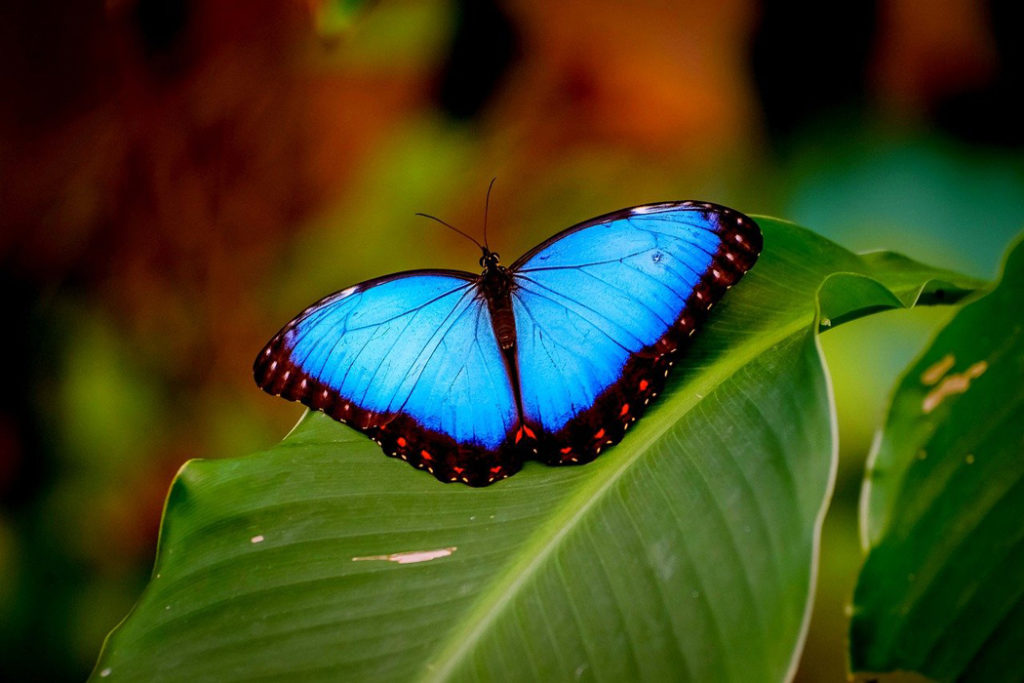
A stunning splash of colour in the forest is the Brazilian Morpho butterfly. These brilliantly blue butterflies have a wingspan of 10 centimetres (4 in). You usually spot them flapping lazily along open corridors through forests or along riverbanks on sunny days.
But once they land, they suddenly disappear from view. That’s because the underside of their wings is speckled brown with a pattern of eye-like circles and zigzag lines to help them camouflage while at rest.
You can see them anywhere in the low land forests. Iguazu Falls are quite a good spot for them.
This list of Brazilian animals only begins to scratch the surface. In Brazil, wildlife is so diverse that no single guide could cover every species. This guide covered the animals that you are most likely to see on your travels. So what are your favourite Brazilian animals? Have you already seen them in their natural habitat? Or planning a future trip?
More on watching wildlife in Brazil
- A Practical Guide to Visiting Iguazu Falls in Brazil & Argentina
- Watching wild jaguars in the Pantanal, Brazil
- 35 Amazing Brazilian Animals and Best Places to See Wildlife in Brazil
- On the trail of the ocelot in Brazil
- 11 Stunning South American Wild Cats and Where to See Them
- Top 10 Pantanal Adventures For Your Brazil Holidays
- Brazil Itinerary: watching wildlife in Brazil without breaking the budget
- 7 Fun things to do in Paraty, Brazil
- Maned wolves and Catholic monks of Santuario do Caraça
- Wildlife of Iguazu Falls, Brazil and Argentina

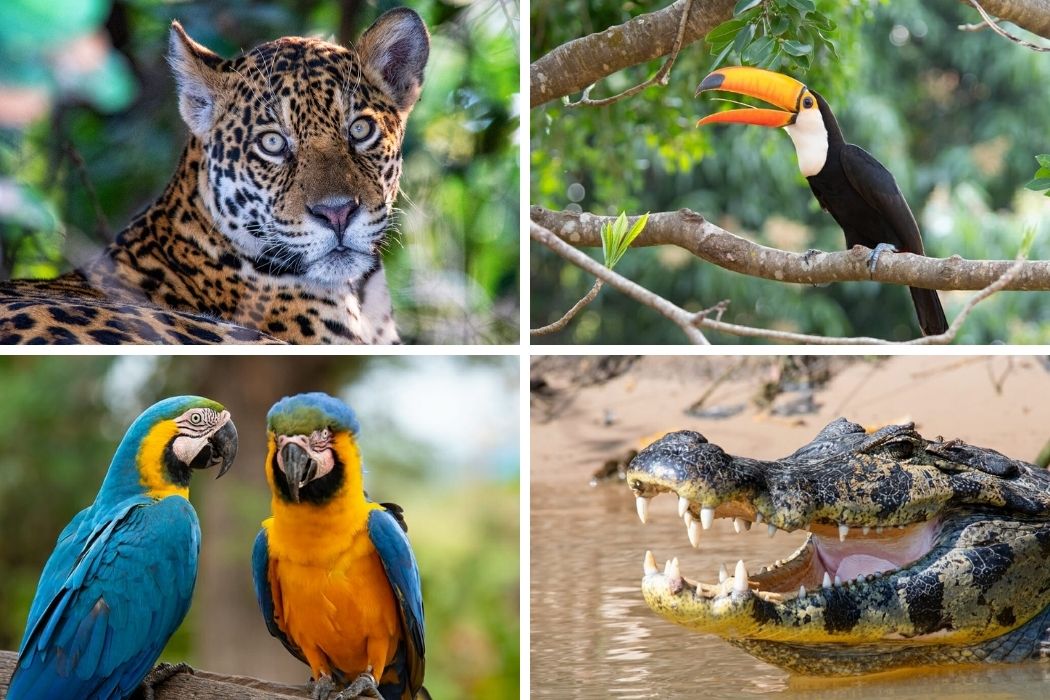
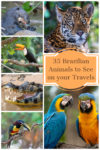
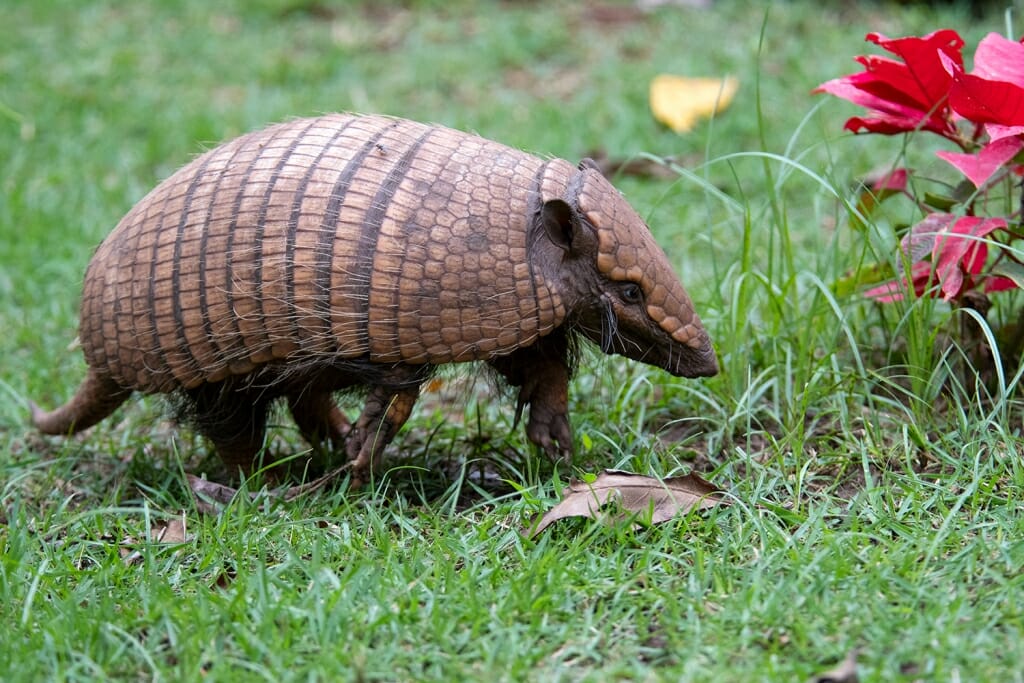
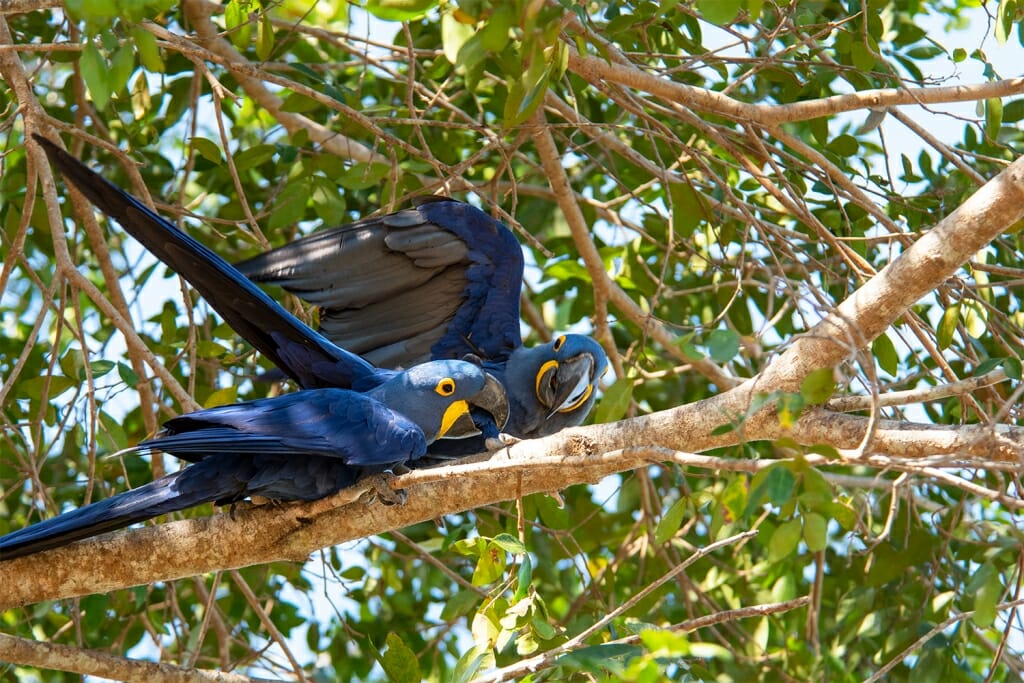
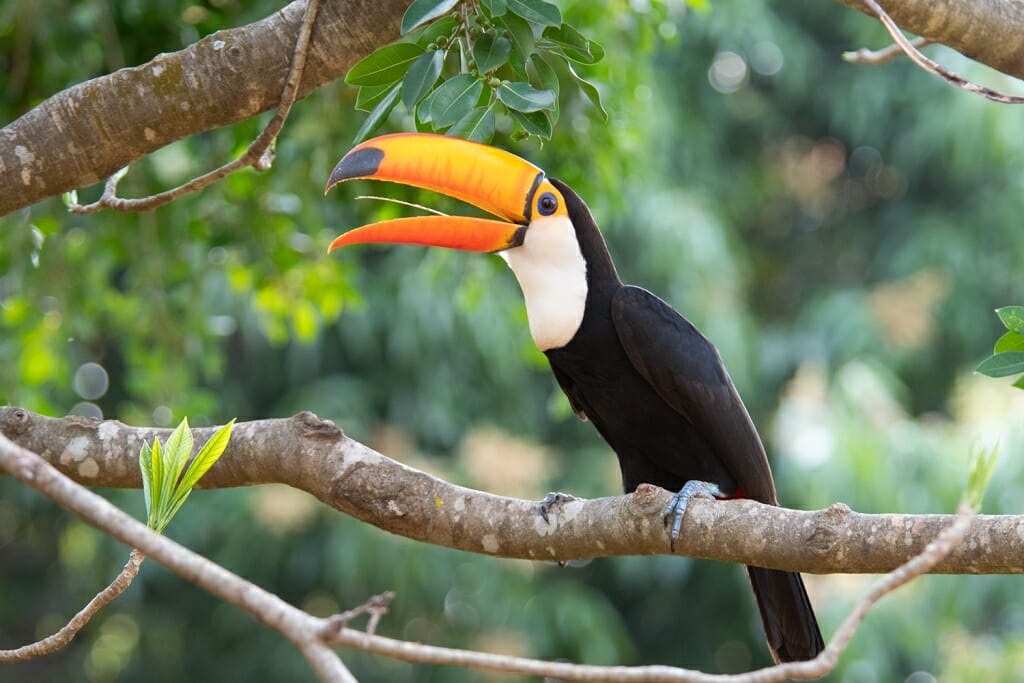

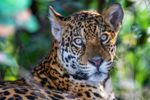
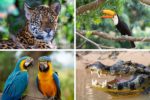
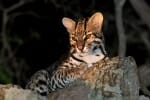
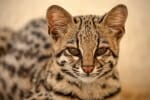
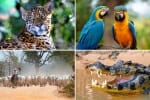
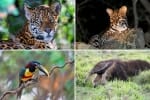
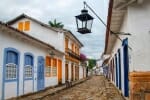
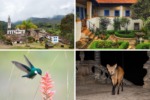
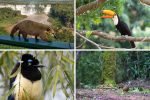
I love spotting wildlife, so Brazil seems to be the perfect country to do that! Thank you so much for sharing all these wonderful animals in their natural habitat :)